HR strategy presentation: A comprehensive guide
Boost HR strategy with this guide. Build a high-performing workforce and achieve business goals
Raja Bothra
Building presentations

Whether you're an HR professional, a manager, or a business leader, understanding how to create a compelling HR strategy presentation is essential.
In this comprehensive guide, we'll delve into the intricacies of HR strategy presentations, exploring what they are, their benefits, and how to structure them for maximum impact. So, let's embark on this journey of transforming your HR presentations into persuasive masterpieces.

What is HR strategy?
HR, short for Human Resources, is the lifeblood of any organization. It encompasses the people, policies, and practices that drive a company forward. Your HR strategy, in essence, is the roadmap that outlines how you plan to manage your organization's human capital to achieve its goals and objectives.
Your HR strategy should align with your company's broader business strategy. It's not just about hiring and firing; it's about creating an environment where employees can thrive, where their skills are developed, and where they're empowered to contribute to the company's success.
Benefits of HR strategy presentation
Before we dive deeper into the art of creating HR strategy presentations, let's explore why they matter:
- Alignment with Business Goals : An effective HR strategy presentation ensures that your human resources align with your organization's broader business goals. It serves as a bridge between HR and the company's mission.
- Clarity of Vision : Presenting your HR strategy clarifies your vision for managing your most valuable asset—your employees. It communicates your intentions, priorities, and values.
- Engagement and Buy-In : Engaging presentations can inspire buy-in from stakeholders and employees alike. When people understand the 'why' and 'how' of your HR strategy, they are more likely to support it.
- Performance Improvement : By outlining your strategy, you set the stage for performance improvement. Clear goals and expectations lead to enhanced productivity.
- Competitive Advantage : A well-crafted HR strategy can be a source of competitive advantage. It helps you attract, retain, and develop top talent, which can set your organization apart.
How to structure an effective HR strategy presentation
Creating a persuasive HR strategy presentation involves a structured approach. Here's a step-by-step guide to help you craft a compelling narrative:
1. Understand your audience : Start by understanding your audience's preferences, needs, and pain points. Tailor your presentation to resonate with their interests.
2. Define your objectives : Clearly define what you aim to achieve with your HR strategy presentation. Are you seeking approval for a new initiative? Are you addressing HR challenges? Be specific about your goals.
3. Storytelling : Effective presentations are like stories. Weave a narrative that captivates your audience. Share real-world examples and anecdotes to make your points relatable.
4. Visual appeal : Use Prezent's stunning templates and slides to create visual appeal. A well-designed presentation enhances engagement and retention of information.
5. Data and metrics : Support your strategy with data and metrics. Use terms like "metric" and "best practices" to show that your approach is grounded in evidence and industry standards.
6. Engagement strategies : Explore strategies to keep your audience engaged throughout the presentation. Incorporate interactive elements, such as polls or Q&A sessions.
7. Simplicity and clarity : Avoid jargon and complexity. Use common words and phrases to ensure your message is easily understood. Terms like "HR plan" and "strategy template" should be naturally integrated into your content.
8. Call to action : Conclude your presentation with a clear call to action. What do you want your audience to do next? Summarize key takeaways to reinforce your message.
Here is a guide on HR presentation .
Do’s and don'ts of an HR strategy presentation
Now that we've covered the basics, let's explore some do's and don'ts to ensure your HR strategy presentation hits the mark:
Do's :
- Be audience-centric : Always keep your audience in mind. Use terms like "HR management" and "recruitment" to address their concerns.
- Practice : Rehearse your presentation to perfection. Confidence enhances your authority on the subject.
- Visualize data : Use charts and graphs to visualize data. It makes complex information more digestible.
Don'ts :
- Overwhelm with data : While data is essential, avoid overwhelming your audience with too many metrics.
- Lack of preparation : Don't wing it. Lack of preparation can erode trust and authority.
- Ignore feedback : Be open to feedback and questions. Ignoring them can diminish your perceived expertise.
Summarizing key takeaways
In this comprehensive guide, we've explored the art of crafting effective HR strategy presentations. From understanding your audience to using terms like "HR strategy presentation" and "strategy powerpoint," you now have the tools to create compelling HR presentations that drive change and enhance your organization's human resources practices. We've uncovered key strategies:
- Audience-Centric Approach : Tailor your presentation using terms like "HR strategy presentation" to address audience needs.
- Storytelling Power : Craft engaging narratives with relatable examples and terms like "strategy agenda."
- Visual Impact : Use Prezent's templates and "presentation graphics" for visual appeal.
- Data Reinforcement : Back your strategy with data, integrating terms like "metric" and "best practices."
- Engagement Strategies : Keep the audience engaged, highlighting "talent management" and "recruitment."
- Clarity and Simplicity : Use common words like "HR plan" for clear communication.
- Inspire Action : Conclude with a call to action, emphasizing "HR management" and "performance appraisal" as actionable steps.
Here is a guide on recruitment presentation .
1. What is the significance of a well-crafted HR strategy presentation?
A well-crafted HR strategy presentation serves as the linchpin for aligning your organization's human resources with its overarching business goals. It's not merely a PPT; it's your roadmap for achieving success. By effectively communicating your "human resource strategy," you empower your team to understand and execute your "strategic plan," fostering "organizational" growth and success.
2. How can I make my HR strategy presentation more engaging and impactful?
To enhance engagement and impact, consider using a "strategy PowerPoint template" or a "strategy PowerPoint presentation" template. These visually appealing templates can elevate your presentation's effectiveness. Additionally, incorporating elements of "change management" and "organizational culture" can help make your message resonate with your audience.
3. What role does HR department play in creating an effective HR strategy presentation?
The HR department plays a pivotal role in crafting and delivering HR strategy presentations. Their expertise in "human resource management" and "strategic human resource" practices is invaluable. They are responsible for outlining the "human resource plan" and ensuring it aligns with broader organizational goals. Furthermore, HR's involvement in "onboarding" and "training and development" can strengthen the presentation's content.
4. How can HR strategy presentations contribute to employee retention and talent management?
HR strategy presentations play a vital role in "attracting and retaining" top talent. They outline a clear path for "career development" opportunities within the organization, emphasizing the value of "diversity and inclusion" and "retention strategies." By showcasing a "differentiation strategy" that recognizes and rewards the "best talent," HR can drive employee satisfaction and long-term commitment.
5. What key elements should I include in my HR strategy presentation to address HR problems effectively?
To address HR problems comprehensively, your presentation should encompass elements like " performance management ," " roles and responsibilities ," and a "plan of action." Highlight how your "strategic human resource management" approach supports "strategic decision-making." Ensure that your solutions are "relevant to the audience" and emphasize the importance of "supporting the corporate" mission. By selecting the "best method" and fostering an approach that "builds understanding," you can tackle HR challenges effectively and enhance "business performance."
Create your HR strategy presentation with prezent
To take your HR strategy presentations to the next level, consider using Prezent, the AI presentation software trusted by Fortune companies. With its array of templates, real-time collaboration, and brand-approved designs, Prezent streamlines the presentation creation process, saving you time and ensuring your presentations are always on brand.
Remember to blend expertise with engaging storytelling, and always keep your audience at the forefront. With the right approach and the assistance of tools like Prezent, you can create HR strategy presentations that resonate, inspire, and drive positive change.
So, go ahead and start crafting your HR strategy presentation masterpiece with confidence! Try our Free Trial or book a Demo today with Prezent!
More zenpedia articles

Speak to their minds: Understand the psychology of the audience

The ultimate and effective presentation checklist: From planning to applause!

Best practices to create and deliver effective presentations
Get the latest from Prezent community
Join thousands of subscribers who receive our best practices on communication, storytelling, presentation design, and more. New tips weekly. (No spam, we promise!)

- What is Strategy?
- Business Models
- Developing a Strategy
- Strategic Planning
- Competitive Advantage
- Growth Strategy
- Market Strategy
- Customer Strategy
- Geographic Strategy
- Product Strategy
- Service Strategy
- Pricing Strategy
- Distribution Strategy
- Sales Strategy
- Marketing Strategy
- Digital Marketing Strategy
- Organizational Strategy
- HR Strategy – Organizational Design
- HR Strategy – Employee Journey & Culture
- Process Strategy
- Procurement Strategy
- Cost and Capital Strategy
- Business Value
- Market Analysis
- Problem Solving Skills
- Strategic Options
- Business Analytics
- Strategic Decision Making
- Process Improvement
- Project Planning
- Team Leadership
- Personal Development
- Leadership Maturity Model
- Leadership Team Strategy
- The Leadership Team
- Leadership Mindset
- Communication & Collaboration
- Problem Solving
- Decision Making
- People Leadership
- Strategic Execution
- Executive Coaching
- Strategy Coaching
- Business Transformation
- Strategy Workshops
- Leadership Strategy Survey
- Leadership Training
- Who’s Joe?
HR STRATEGY - EMPLOYEE JOURNEY & CULTURE
The big picture on employee journey & culture, hr strategy - culture.
Culture is not some fuzzy, intangible organizational concept. Culture is grounded in an organization's values, reflected by the norms, behaviors, and language of team members, nurtured by the environment team members work in, and reinforced by the organization's compensation and benefits. If you want to improve an organization's culture, then improve the values, norms, language, environment, compensation, and benefits.
Furthermore, an organization's culture should be reflected, celebrated, and reinforced throughout the employee journey. If you get the culture and employee journey right, you set the foundation for happy, fulfilled, and productive team members.

Does your company have a value statement ? Can all the team members recite it from memory? Is it reflected in the norms, behavior, language, environment, benefits, and compensation? If it isn't then the values are probably doing more harm than good to the culture.
Culture can make or break a company, so get the four building blocks of culture right. Any culture strategy starts with the leadership asking some tough questions about values, norms & language, the environment, benefits, and compensation.

Culture Strategy on One Page

Read about the role and competencies of a Strategic Chief Human Resources Officer (CHRO)
How Does Google (#1 Place to Work) Do Culture
Google takes culture seriously. They have a People Analytics team to measure the impact of different cultural and employee journey practices. They may have a few too many values (below), but they are insightful, and catchy and serve as a strong foundation for Google's culture.
Google has five stated norms of psychological safety, dependability, structure & clarity, the meaning of work, and impact of work. Their norms reinforce their values.
Google spends significant resources and research on creating productive and collaborative environments. Google needs top talent, and its benefits and compensation ensure that it can attract and retain that top talent.
The main point about Google is the purposefulness of the leadership in crafting and nurturing Google's culture.

1. VALUES - THE FOUNDATION OF THE ORG
As Roy Disney, the older brother of Walt Disney said, “When your values are clear to you, making decisions becomes easier.”
What are the values that will help team members, individually and collectively, achieve the mission of the organization?
Frankly, most company value statements are generic, forgettable, and not utilized as the cultural foundation. If this is your company, start over, and spend some serious time brainstorming and engaging team members on what the soul and core values of the company are.
Once you figure out the core values, make them pithy, and rememberable, and then celebrate them, internally market them, weave them into the organizational language, refer to them, utilize them in decision-making, and embed them within the various strategies across the business model . Below is the values idea map, which may give you some ideas on potential values.

An Example of a Cool Value Statement
For a software company, we worked with the management team and employees to create core values that were authentic and important to team members.

Embedding Values into the employee journey

2. NORMS - OUR BEHAVIOR DEFINES US
Norms are the widely accepted individual and interpersonal behaviors in an organization, which should reflect the values. While values are the foundation of a culture, norms are the embodiment and manifestation of them within the culture.
A new employee views and feels a culture through the norms of how team members treat themselves and each other. The adage "lead by example" is crucial to the norms of an organization. People learn through mimicry, and leaders need to live the values and reinforce the norms of an organization.
Norms permeate through all interactions, including conversations, meetings, emails, communications , Slack, events, projects , and personal and external interactions.

Amazon's Meeting Norms
Early on in Amazon's history, Jeff Bezos instilled very thoughtful norms around meetings. Valuing problem solving and productivity, Jeff enacted five norms for meetings. The details are in the graphic.
Imagine being a new Amazon employee attending your first meeting. You would probably be a bit shocked, but also appreciative of the purposefulness of the norms and ritual.
The point is, norms are where culture and reality collide. The more purposeful an organization is at defining and reinforcing the norms, the stronger the culture will become.

3. ENVIRONMENT - THE BIG, OVERLOOKED CULTURAL ENABLER
We often overlook the environment as a strategic driver of culture, values, and organizational performance. As a society, we spend so much time, attention, and money on the interior design of our homes. It is the complete opposite for workspaces, where millions spend 40+ hours a week.
Small strategic investments in workspaces can pay large dividends. Think about simple ideas, like putting up posters of the organizational values , employees living those values, recent successes, customer logos, and other messages you want to reinforce. You can name conference rooms after clients or the core values. Or, you can make meaningful investments to transform workspaces to be collaborative, supportive, and engaging spaces of productivity, like Google does (examples below).
The takeaway is to be purposeful in workspace design and decor. Understand what values or cultural elements you want the environment to support, and then build them into the environment.

4. COMPENSATION & BENEFITS - REWARD BEHAVIORS

THE EMPLOYEE JOURNEY
Much like the customer journey is a core component of corporate strategy, the employee journey is a core component of HR strategy. At a high level, the employee journey includes recruiting, hiring, onboarding, development, evaluation, and advancement. Companies with strong employee journeys help elevate and realize the potential of their team members and utilize the employee journey to reinforce their culture.
To develop a strong employee journey strategy engage team members in diagnosing issues, coming up with goals, ideas initiatives, and executing the initiatives. An employee journey strategy comes down to answering four fundamental questions, which are below.

An Employee Journey Strategy

Employee Journey Strategy Ideas

Google's Employee Journey
Google is the #1 place to work, in large part because of their focus on improving their employee journey. Check out some of their employee journey strategy examples.

CREATING A KILLER CULTURE AND EMPLOYEE JOURNEY STRATEGY
The output of a culture and employee strategy are goals and initiatives. The challenge comes in figuring out the optimal goals and initiatives that will help elevate and realize the potential of team members. Below are the four steps to a successful employee journey and cultural transformation .
Engage team members throughout the process, especially in diagnosing and ideating. The more team member engagement, the more buy-in and the higher chance of transformational success.

HR Diagnostic Survey

FINAL THOUGHTS ON CULTURE & EMPLOYEE JOURNEY STRATEGY
Given the importance of elevating and realizing the potential of the individuals and teams that drive the development and execution of a company's strategies, embarking on developing a strong employee journey strategy is a no-brainer. In every company, there is a lot of upside in strengthening the culture and employee journey. Just be sure to engage the entire organization in generating, prioritizing , and implementing cultural and employee journey initiatives.
If you want to talk about your HR & Org strategy with an experienced strategy coach, set up some time with Joe Newsum , a Mckinsey Alum, and the author of this content and website.
DOWNLOAD THE HR & Org strategy presentation template
Download the 185-page HR & Org Strategy PowerPoint Presentation . The fully editable and professionally designed deck will give you a jump start on your HR & Org Strategy.
DOWNLOAD THE CULTURE & EMPLOYEE JOURNEY STRATEGY TEMPLATES
To get you started on developing a killer culture and employee journey strategy, download the free PowerPoint, which includes: 1. Mission & Values Template 2. Culture Strategy Worksheet 3. Employee Journey Ideation Worksheet 4. Employee Journey One-Page Strategy 5. Employee Journey & Culture Strategy Overview Download
Check out The Employee Strategy Survey
DOWNLOAD STRATEGY PRESENTATION TEMPLATES
THE $150 VALUE PACK - 600 SLIDES 168-PAGE COMPENDIUM OF STRATEGY FRAMEWORKS & TEMPLATES 186-PAGE HR & ORG STRATEGY PRESENTATION 100-PAGE SALES PLAN PRESENTATION 121-PAGE STRATEGIC PLAN & COMPANY OVERVIEW PRESENTATION 114-PAGE MARKET & COMPETITIVE ANALYSIS PRESENTATION 18-PAGE BUSINESS MODEL TEMPLATE
JOE NEWSUM COACHING

EXECUTIVE COACHING STRATEGY COACHING ELEVATE360 BUSINESS TRANSFORMATION STRATEGY WORKSHOPS LEADERSHIP STRATEGY SURVEY & WORKSHOP STRATEGY & LEADERSHIP TRAINING
THE LEADERSHIP MATURITY MODEL
Explore other types of strategy.
BIG PICTURE WHAT IS STRATEGY? BUSINESS MODEL COMP. ADVANTAGE GROWTH
TARGETS MARKET CUSTOMER GEOGRAPHIC
VALUE PROPOSITION PRODUCT SERVICE PRICING
GO TO MARKET DISTRIBUTION SALES MARKETING
ORGANIZATIONAL ORG DESIGN HR & CULTURE PROCESS PARTNER
EXPLORE THE TOP 100 STRATEGIC LEADERSHIP COMPETENCIES
TYPES OF VALUE MARKET ANALYSIS PROBLEM SOLVING
OPTION CREATION ANALYTICS DECISION MAKING PROCESS TOOLS
PLANNING & PROJECTS PEOPLE LEADERSHIP PERSONAL DEVELOPMENT
Home Blog Business HR Strategic Planning 101: A Guide for Developing HR Strategies
HR Strategic Planning 101: A Guide for Developing HR Strategies
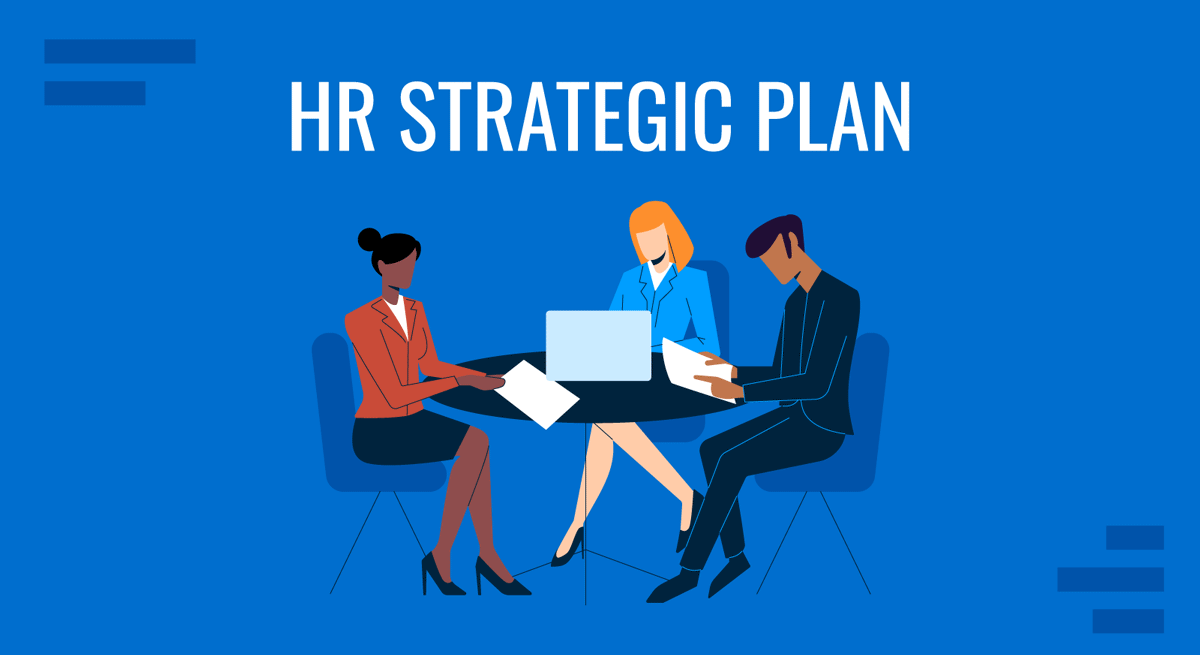
Regardless of size or industry, every organization operates with specific goals and objectives. The job of the human resources (HR) team is to ensure that the workforce contributes effectively to its success. However, the shocking truth is many initiatives fail because there is a disparity between HR strategies and the business.
In a survey by Gartner , 38% of the HR leaders surveyed admitted that their HR strategic planning process is not aligned with the business strategic planning calendar. Such a misalignment can have significant implications and may impede the organization’s overall success.
This underscores the need for HR teams to prioritize a strategic plan that’s in sync with the overall business framework. How do you do that? Let’s discuss it in this article.
Table of Contents
What is an HR Strategic Plan?
Components of an hr strategic plan, steps for creating an hr strategic plan, examples of hr strategic plan slides, how to present an hr strategic plan.
We’ve defined a strategic plan as a document that reflects how a company plans to function and grow over a significant period. Its purpose is to allow all departments to understand the company’s larger strategy and guide their respective efforts so that they can positively impact its success.
Hence, the HR strategic plan is a document that outlines how the human resources function will align with and support the overall strategy, vision, and goals of the organization. Whether the HR strategy involves hiring more staff, promoting talent development, or nurturing a positive work culture, it should be firmly based on the direction the company aims for.
It’s important to emphasize that HR strategic planning is an ongoing process and requires continual reassessment as the organization’s overall strategic plan evolves.
So, where do you start with HR strategic planning? Breaking down the plan’s components is the easiest approach to accomplish this process. Let’s explore the basic elements an HR strategic plan should include.
- The Vision is the aspirational image of what the HR function aims to achieve in alignment with the organization’s overall goals. It encapsulates the desired future state of HR within the company.
- The Objectives are the short-term and long-term goals HR sets to achieve. These goals should be directly tied to the broader business strategy.
- The Actions detail the specific steps, initiatives, and projects HR will undertake to achieve its objectives.
- The KPIs are the metrics that gauge the effectiveness and impact of HR initiatives. They help monitor performance and guide adjustments if necessary.
1. Pick a Strategic Model to Use
Selecting the right structure for an HR strategic plan is the first step to effectively communicating the plan’s outcomes within your organization. SlideModel has several editable strategic planning templates to help you organize your plan clearly and logically.
The Goals-Based Strategic Planning Model begins by identifying goals/objectives and aligning the strategies and action plan with the organization’s current state. It also outlines the timelines for implementation and key metrics for tracking the progress.
The Cascade Strategy Planning Model involves a top-down approach that starts with defining the organization’s mission, vision, and core values. From there, strategic goals are broken down into actionable objectives for various departments and teams.
Regardless of your chosen model, covering the essential elements mentioned earlier is imperative to ensure the plan’s effectiveness in driving organizational success.
2. Assess Current HR State
You now have the strategic planning model to work with. The next step is to conduct a gap analysis that evaluates the existing state of your human resources concerning the company’s overarching vision. This analysis compares where your HR function is and where you want it to be and identifies the existing gaps so that you can develop reasonable goals to fill them.
Several gap analysis templates , like the SWOT analysis , can aid you in this process.
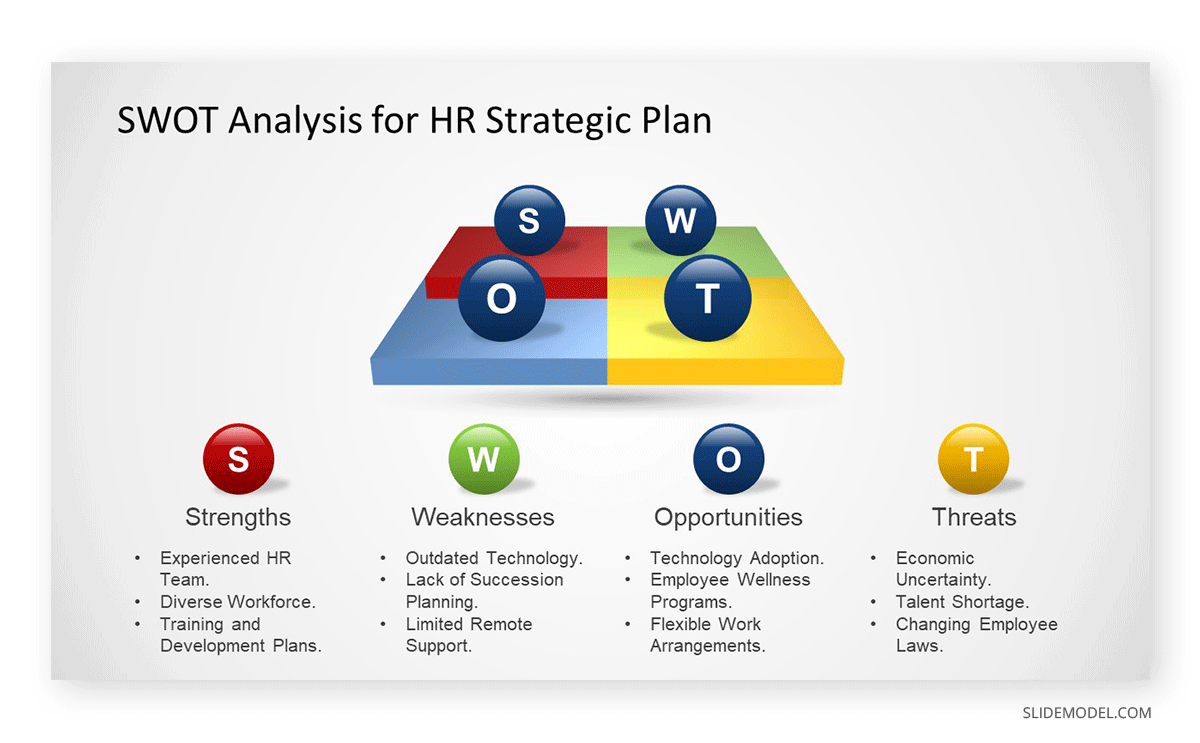
Start by making a checklist of your requirements to fulfill the vision. Then, look at your organization’s workforce and identify what practices could be improved or what capacity could be acquired to realize the organization’s overarching strategic goal.
For instance, imagine you’re part of Tesla’s HR team, whose vision is to “create the most compelling car company of the 21st century by driving the world’s transition to electric vehicles.” As you assess your HR state, the gap analysis might reveal your need for recruiting specialized engineers or more employee training programs on sustainable transportation concepts.
3. Define HR Vision
Building upon the insights gained from the gap analysis, the next step is to craft a clear and aspirational vision for your HR function. This vision should reflect how HR envisions contributing to the organization’s success.
Some may find this step unnecessary, but we don’t recommend skipping it. As we mention in our vision statement article, a vision statement codifies your aspirations, making it easier to communicate them to stakeholders. An HR vision statement is no different.
Continuing our illustrative example, Tesla’s HR vision could be:
“Lead the charge in cultivating a dynamic and innovative workforce that pioneers the electric vehicle revolution.”
This ambitious statement points to areas where the HR team can play a crucial role in bridging the gaps between the workforce and the direction that Tesla is going for.
4. Identify Objectives
We cannot overstate the significance of setting objectives in HR strategic planning. While you have the vision to guide your actions, you need clearer directions to make your journey easier. Objectives transform abstract visions into concrete and actionable goals that you can work on.
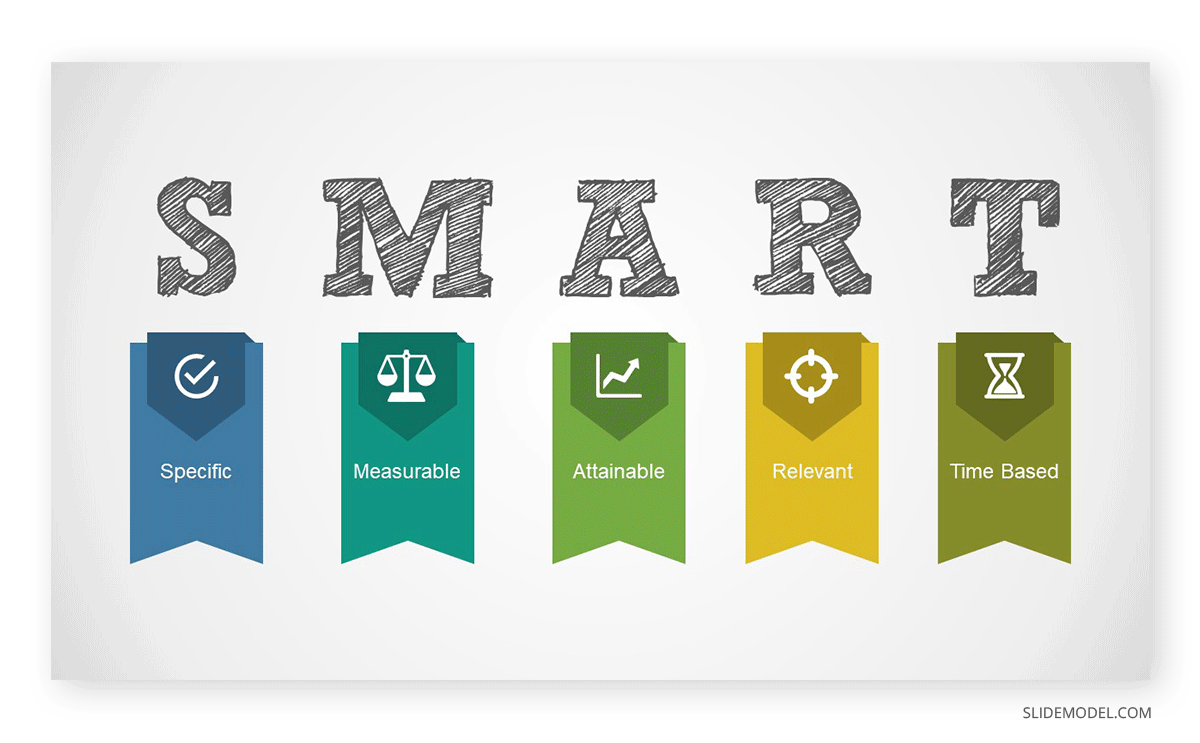
You may identify short-term and long-term objectives. Either way, they should adhere to the SMART criteria :
Specific: Clearly define what the objective aims to achieve.
Measurable: Set quantifiable metrics to gauge success.
Achievable: Ensure the objective is feasible and realistic.
Relevant: The objective should align with HR’s role and the organizational strategy.
Time-Bound: Set a clear timeline for achieving the objective.
Let’s take a look at a well-written objective for Tesla’s HR.
Increase the number of engineers with proficiency in battery management by 20% within the next two years.
This objective aligns with the organization’s broader goal of pioneering the electric vehicle revolution. Battery management is a critical component of electric vehicles. By increasing the number of engineers proficient in battery management, Tesla’s HR ensures a workforce with the skills needed to advance electric vehicle innovation.
5. Develop Action Plans
The action plan breaks down your objectives into achievable pieces, giving stakeholders a clear sight of the steps needed to accomplish them. It lays down the specific activities in the order in which they should be carried out, the resources and support needed, and the completion timeline. The structured nature of action ensures that everyone is on the same page regarding the steps needed to achieve the desired outcomes.
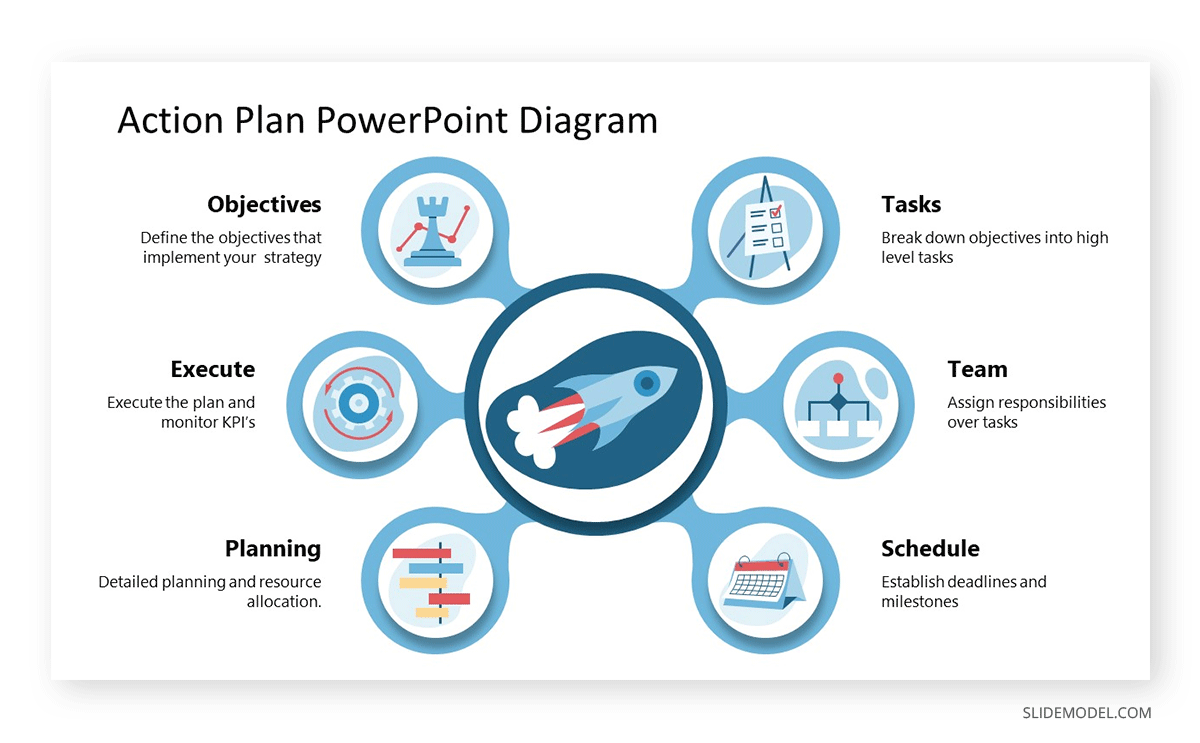
For example, the following could be Tesla’s activities in achieving its objective of increasing the number of engineers proficient in battery management:
- Assess the current proficiency levels of engineers in battery management skills.
- Design a comprehensive battery management training.
- Roll out the battery management training program.
- Assess the progress of engineers’ proficiency levels.
You may use a one-pager action plan template to present these activities, their dependencies, and their required resources.
6. Establish KPIs
How will you measure success? As you develop your HR strategic goal, you will realize that you need to come up with a consensus of what success looks like. This is where key performance indicators (KPIs) come in.
Forbes defines KPI as a measurable target indicating a specific performance is at par with the goal. It requires looking into past performance variables (lagging indicators) and the desired future performance (leading indicators) to inform managers that they are on track to meet their objectives and, to a certain degree, their vision.
KPIs vary depending on the organization’s goals, but some common performance indicators for HR include:
- Employee Productivity
- Employee Attrition/ Retention Rate
- Cost per Hire
- Training and Development Metrics
When it comes to increasing the number of engineers with proficiency in battery management, Tesla’s KPIs may include:
- Proficiency Assessment Scores
- Training Completion Rate
- Number of Certified Engineers
Here are a couple of examples of HR strategic plans presented using various models:
1. Enhancing Employee Engagement
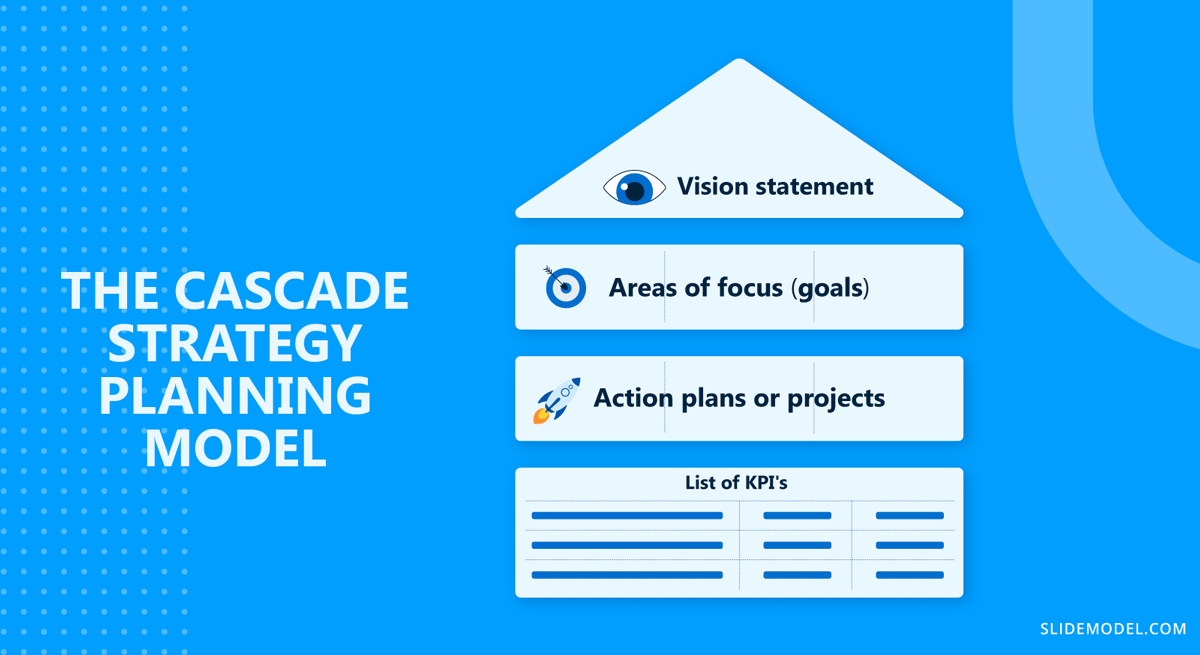
This is an example slide of an HR strategic plan of a company that aims to enhance employee engagement. Using the Cascade Strategy Planning Model, they were able to align and direct every facet of their initiatives toward their overarching vision.
2. Developing Leadership Pipeline
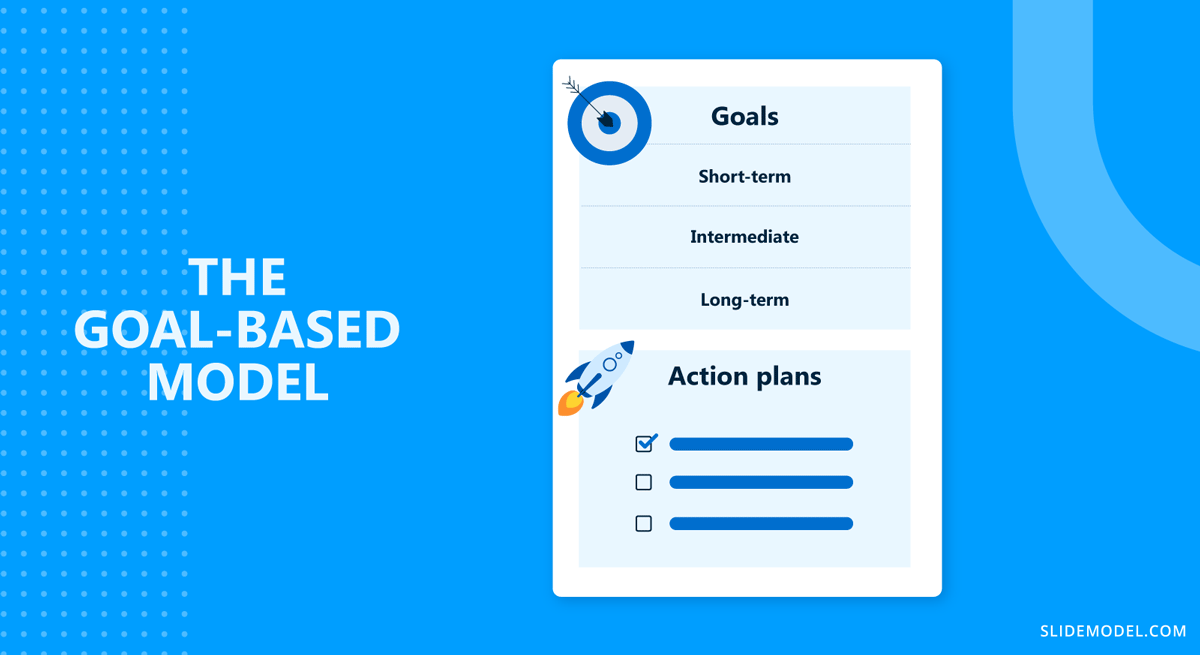
This goal-based HR strategic plan example provides an actionable approach to achieving the outlined goals for developing a leadership pipeline within the organization. Incorporating specific timelines into the action plan helps ensure the strategic plan progresses smoothly and stays on track.
Some companies spend a lot of effort developing HR strategies, or strategic plans in general, only to forget to effectively communicate them to the people who will turn the plan into a reality. What’s the point of beautifully crafted strategies when employees know too little or don’t know about them?
Hence, you need a communication plan to ensure that the whole organization understands and embraces your strategies from the ground up. Here are some tips when presenting an HR strategic plan.
1. Use Crystal-clear Language
Using jargon during a presentation may sound smart but may lead to confusion and alienation. To effectively communicate your strategies, prioritize using simple, plain language that resonates with the audience. If jargons are inevitable, provide clear definitions to ensure understanding.
2. Explain the “Why”
Employees may react negatively to changes, especially when they feel the change is an additional burden. Explaining a change’s reasons, motivations, and benefits can alleviate concerns and resistance. For example, if an employee is against HR’s job rotation plan, explaining how it will equip them for future succession might change their mind.
3. Use Visual Aids
HR strategic plans usually involve a lot of projections and metrics that might get lost in translation. Incorporate visual aids like infographics, graphs, and charts to simplify these complex pieces of information.
4. Encourage Two-way Communication
When you don’t receive feedback during a presentation, it typically indicates one of two possibilities: either the audience has a complete grasp of the message, or they don’t get it. There’s only one way to know for sure: to establish a channel for dialogue. Communication in both directions bridges the gap between the intended message and the audience’s understanding.
5. Use Multi-channel Approach
People have different preferences for absorbing information. Some may find in-person presentations more convenient, but others may find it challenging to present complex information. Cognizant of these variations, consider a range of approaches when presenting your HR strategic plan. For example, you may send out a pre-read of your reports so no one gets confused during your meeting.
HR strategic planning is a complex activity that involves multiple processes. It requires a comprehensive and thoughtful approach, from setting clear objectives and identifying key performance indicators to developing actionable plans and ensuring effective communication. The key to effective HR strategies is aligning them with the main company vision and strategic goals.
But remember, HR strategies are not set in stone. As company circumstances change and new challenges and opportunities emerge, the planning team must be agile to accommodate these shifts.
1. HR Plan for an Organization PowerPoint Template
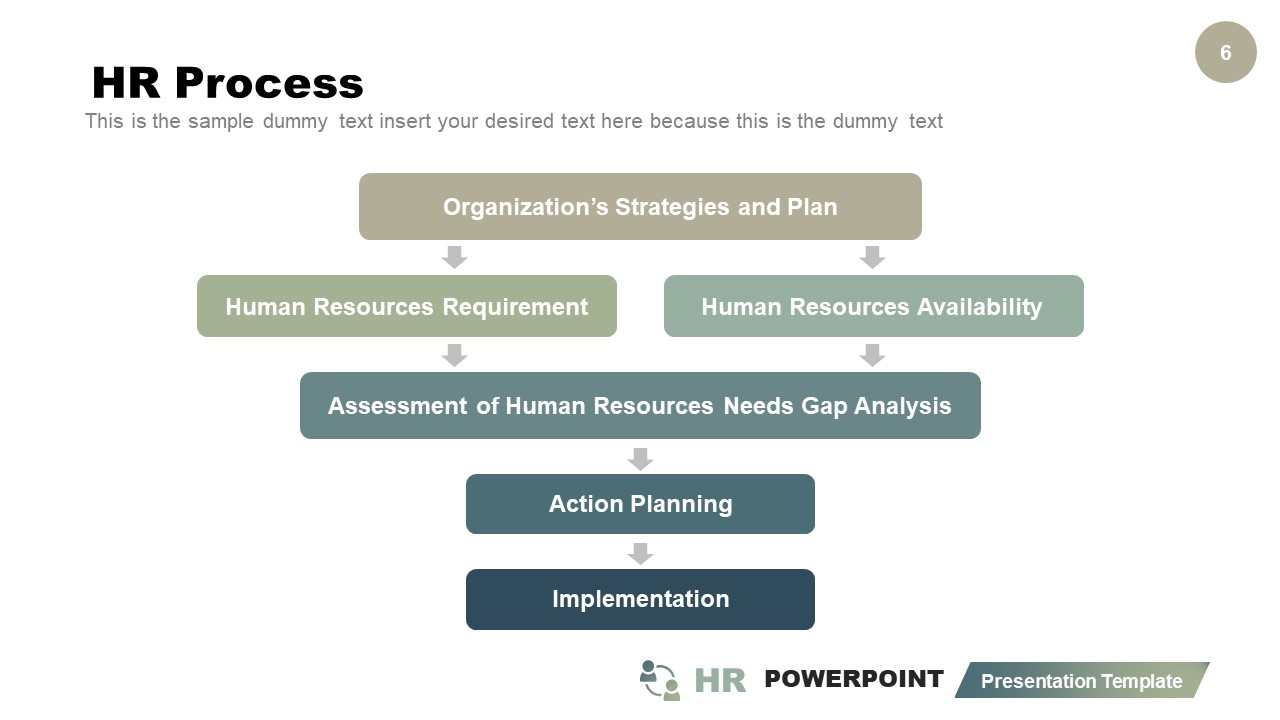
Present your HR Strategic Plan with a slide deck intended for HR Professionals! This HR Strategic Plan template contains tools to outline the most important aspects of the human resources process and management tasks, like hiring new employees, management structure, career management, performance management, hidden opportunities, and more. Your team can craft a presentation that can be continuously updated according to your plan’s agenda, or it can fit the purpose of multiple plans.
Use This Template
2. GOST Canvas for HR Strategic Plan
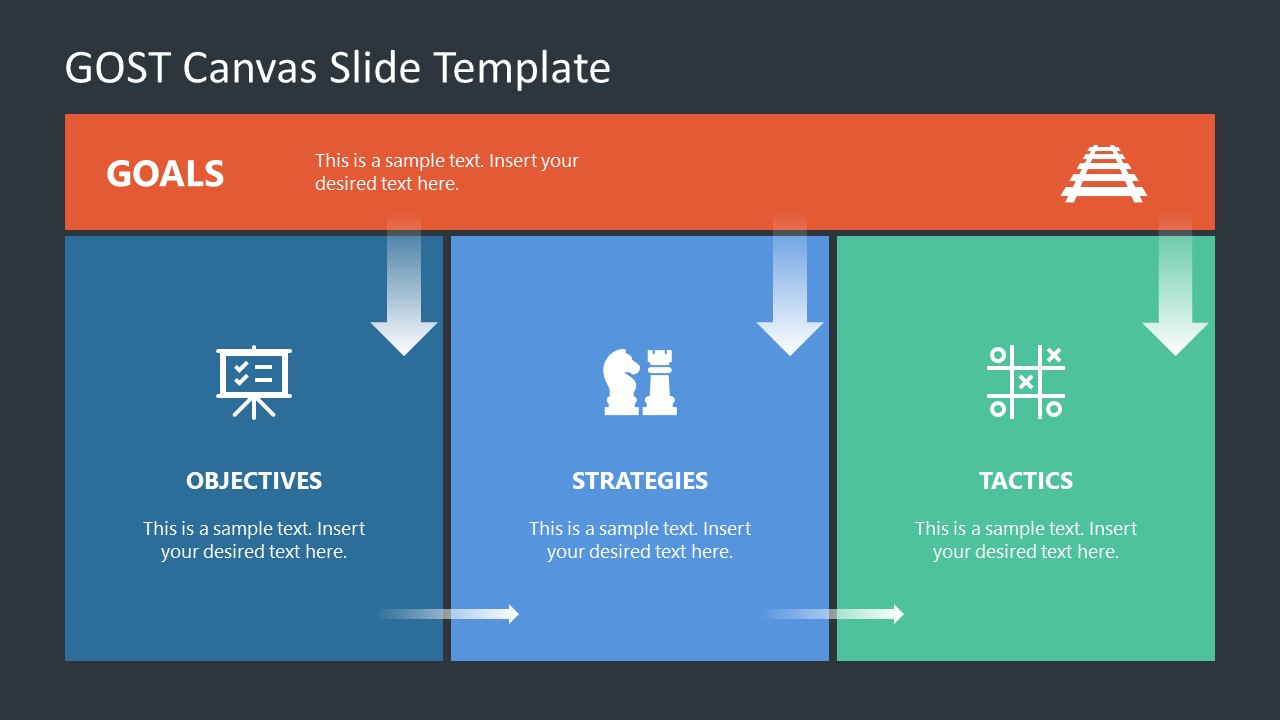
This GOST framework is ideal for processes that require generating goals, laying out strategies, and defining tactics for an actionable plan. For an HR Strategic Plan, we can use this GOST Canvas PowerPoint Template as a prior step to defining the action plan details, while using the findings retrieved from the SWOT analysis and SMART Goal definition stages.
3. Strategic Plan HR Strategy Template for Defining Vision & Mission
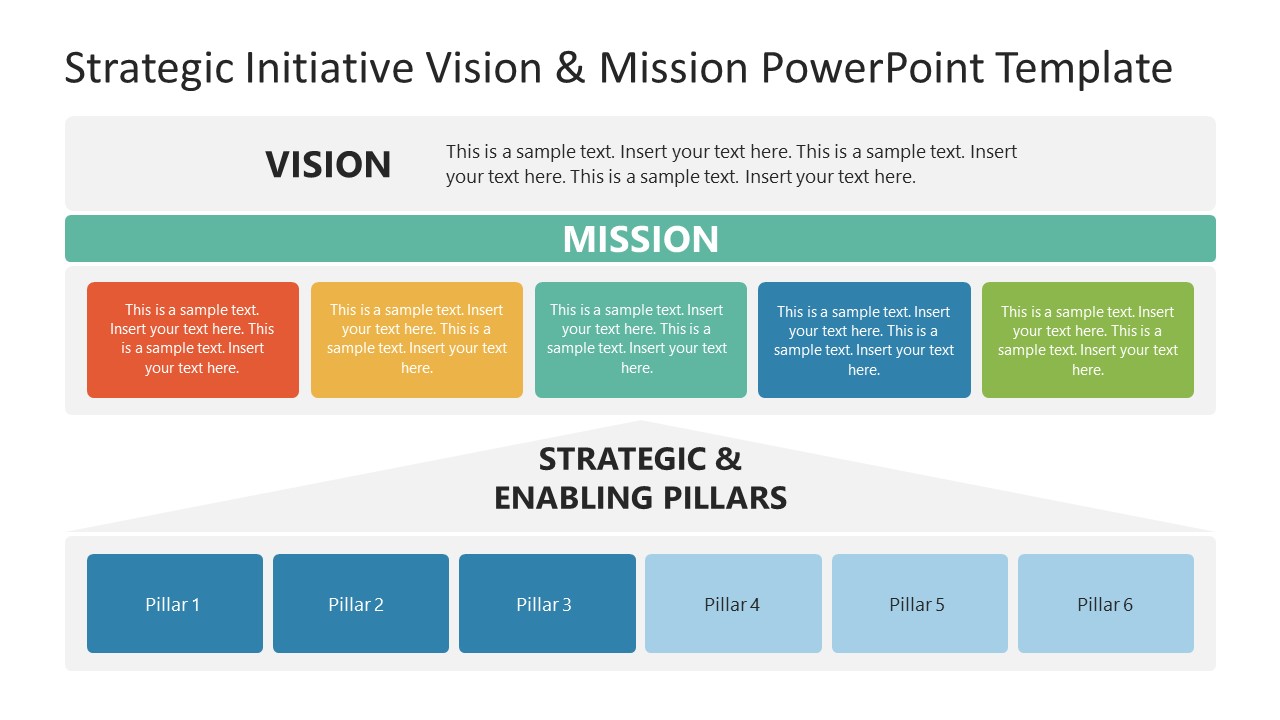
The third step in our HR Strategic Plan guide is to define the HR Vision. Although this can be managed through Vision Statement templates, we believe a tailored template that exposes both Mission and Vision better fits this context.
Use this colorful Strategic Initiative Vision & Mission PowerPoint Template to formulate a path by which your strategic plan can align its efforts to meet the established goals. Strategic and Enabling Pillars are also laid out in an extremely visual format while being connected to the Mission. This way, stakeholders can get a quick glimpse of why certain tactics are being pursued, to which pillar they belong, and how that aligns with the big picture in the Strategic Plan.
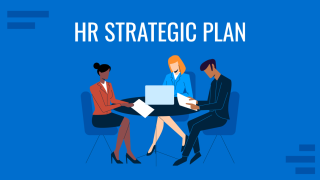
Like this article? Please share
HR, Human Resources, Planning Filed under Business
Related Articles
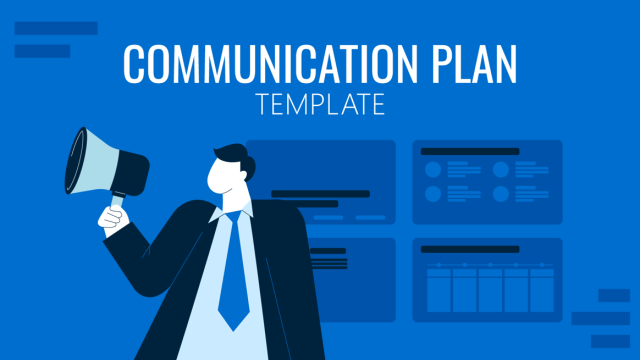
Filed under Business • December 7th, 2023
The Communication Plan Template
Discover why communication plan templates are a key asset for strategic structuring of information in organizations. Learn how to build one here.
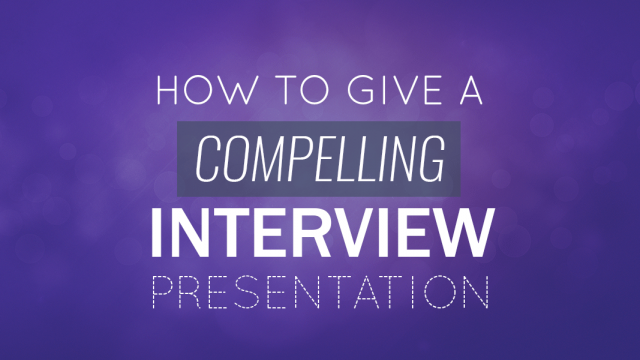
Filed under Presentation Ideas • October 6th, 2023
How to Give A Compelling Interview Presentation: Tips, Examples and Topic Ideas
Interview presentations have now become the new norm for most industries. They are popular for sales, marketing, technology, and academic positions. If you have been asked to deliver one for your job interview presentation, prepare to build a strong case for yourself as a candidate. Giving a general presentation is already daunting. But selling yourself […]
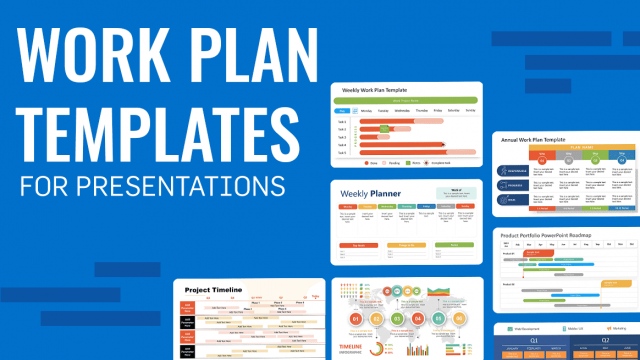
Filed under Business • September 8th, 2023
Best Workplan Templates to Organize your Tasks
Create Professional Work Plan Presentations with our suggested Work Plan Templates.
Leave a Reply
We use essential cookies to make Venngage work. By clicking “Accept All Cookies”, you agree to the storing of cookies on your device to enhance site navigation, analyze site usage, and assist in our marketing efforts.
Manage Cookies
Cookies and similar technologies collect certain information about how you’re using our website. Some of them are essential, and without them you wouldn’t be able to use Venngage. But others are optional, and you get to choose whether we use them or not.
Strictly Necessary Cookies
These cookies are always on, as they’re essential for making Venngage work, and making it safe. Without these cookies, services you’ve asked for can’t be provided.
Show cookie providers
- Google Login
Functionality Cookies
These cookies help us provide enhanced functionality and personalisation, and remember your settings. They may be set by us or by third party providers.
Performance Cookies
These cookies help us analyze how many people are using Venngage, where they come from and how they're using it. If you opt out of these cookies, we can’t get feedback to make Venngage better for you and all our users.
- Google Analytics
Targeting Cookies
These cookies are set by our advertising partners to track your activity and show you relevant Venngage ads on other sites as you browse the internet.
- Google Tag Manager
- Infographics
- Daily Infographics
- Popular Templates
- Accessibility
- Graphic Design
- Graphs and Charts
- Data Visualization
- Human Resources
- Beginner Guides
Blog Human Resources 6 Steps to Create a Strategic HR Plan [With Templates]
6 Steps to Create a Strategic HR Plan [With Templates]
Written by: Jessie Strongitharm Aug 25, 2022

The backbone of any successful business is the people and processes behind it — that’s why creating a human resources (HR) plan is key. This strategic document drives your business forward by evaluating where your workforce is at, and comparing it to future needs.
Without an HR plan, organizations can suffer from issues that would have otherwise been avoided. From productivity pitfalls to costly employee turnover, there’s no shortage of risks you can sidestep if you do human resource planning in advance.
Not sure where to start? No worries. I’ve outlined six steps you can take to create an effective HR plan that ensures your organization is well-staffed and well-served. You’ll also find a variety of HR templates that you can customize in just a few clicks — no design expertise required.
Click to jump ahead:
What is human resource planning?
- Assess employees’ current skill levels
- Forecast your labor needs based on available information
- Revisit your organizational design
- Outline how you will manage, motivate and retain talent
- Align your workforce planning with your budget
- Establish KPIs for your human resource planning objectives
Human resource planning is the process of considering the current and future “people needs” of an organization.
This involves evaluating an organization’s workforce structure and protocols to ensure operational goals are met, productivity stays high and future demands for labor and talent can be fulfilled.
The result of this process is the creation of an HR plan, which typically takes the form of a written document sometimes autogenerated using HR software . These documents tend to follow a similar structure to most strategic business plans and are created on an annual basis, by HR managers or company leaders.
Check out the template below for an example.
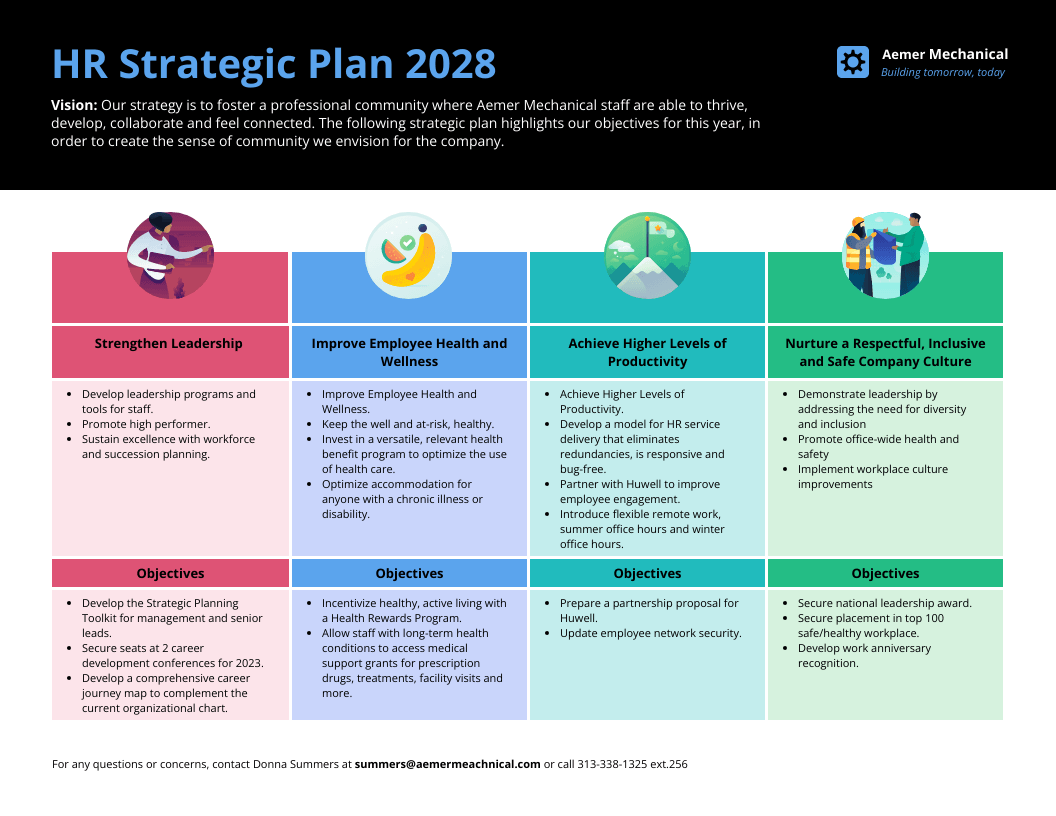
This eye-catching, one-page HR Strategic Plan Template offers a concise summary of your human resource planning efforts, so you can easily share info with colleagues.
Just swap out the text and visual assets for those of your choosing in Venngage’s editor , and you’re off to the races.
6 steps to create a strategic HR plan
Ready to create a strategic plan for the human resources that power your business? Here are six steps to help you succeed at the human resource planning process.
1. Assess current employees’ skill levels
The first step to creating a future-forward HR plan is to assess employees’ current skill sets, and compare them to your operational needs moving forward. This will help you identify gaps and inform any hiring of new employees.
Employees’ skill levels can be assessed by reviewing their work history, hard and soft skills and professional growth over time.
Using a matrix is a great way to understand where the skill gaps in your current workforce exist. Below is an example that describes the skills needed for different marketing roles.
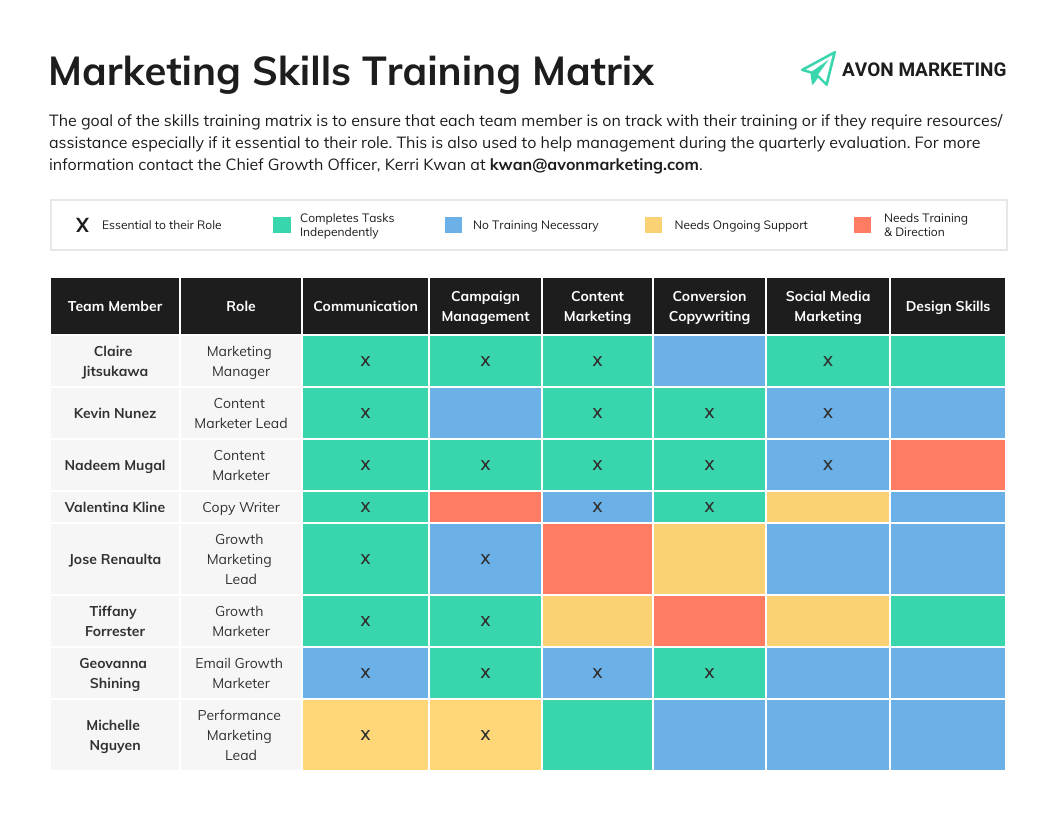
Don’t need it for marketing specifically? No worries — you can fully customize this template by swapping in your own text to examine any human resource gaps.
Another way to assess skills is by giving employees a questionnaire they can fill out. This Employee Competency Assessment Template does just that.

Based on the information collected, you’ll get a sense of what positions best suit each individual, and whether any upskilling or hiring is required.
2. Forecast your labor needs based on available information
Next in your strategic strategic HR management plan, you’ll want to consider the future. This involves accounting for any upcoming changes to your workforce, so operations can continue without error.
When forecasting labor needs, the following should be considered:
- Planned promotions
- Upcoming retirements
- Layoffs
- Personnel transfers
- Extended leaves of absence (i.e. maternity/paternity leave)
Beyond those, it’s a good idea to assess the impact of external conditions on your labor needs during your human resource planning. For example, new technological developments may decrease the amount of employees you require to operate your business.
3. Revisit your organizational design
Organizational design is the process of structuring the way a business operates so it can best achieve its goals. This is hugely important when it comes to your human resource planning process!
With a clear understanding of your organization’s strategic objectives in mind, reviewing your organizational design allows you to understand the staffing requirements you’ll need to succeed at them. This means taking into account your organizational structure and chains of command, as well as how work gets done and the way information flows.
From there, you’ll be able to see which departments need more team members so it can accomplish the organization’s objectives.
An easy way to get started is by using an organizational flow chart.

With its color coding and layout, even a new manager can quickly look at this chart to identify the people responsible for leading teams and making decisions.
And if there are any changes, it’s easy to to reflect them in the chart itself. All you need to do is customize the text and visual assets in Venngage’s Chart Maker as desired.
Not quite your style? There’s plenty of other organizational chart templates to choose from.

Here’s an organizational chart that’s perfect for small businesses that have limited employees. One quick look, and you’re good to go.
The bottom line is, no matter how big or small your business may be, you should always revisit your organizational design to optimize your workforce management and business operations.
Related: Types of Organizational Structure [+ Visualization Tips]
4. Outline how you will manage, motivate and retain talent
In this day and age, it’s a known fact that companies must provide more than just a paycheque to attract and retain talent, and encourage growth.
It’s true — studies have shown employees are more engaged in their work when they feel it is meaningful, fulfilling and slightly challenging. So your human resource plan should consider how to inspire such feelings, and what actions you can take to motivate employees to stay. (Hint: a strong HR training and development program is key.)
The talent management infographic template below is a great way to begin.

Using this process chart , you can detail the steps you’ll take to retain the talent you have. Reference it as needed in your human resource planning.
Another great way to keep staff motivated and geared towards their professional growth is by coming up with ideas for employee development . Facilitating a company culture that champions continuous learning guarantees your team will feel supported and challenged in all the right ways.
The two employee development plan templates below will help you do just that.

Though both templates are geared towards healthcare organizations, it’s easy to customize their content in Venngage to promote the continuous learning and development of employees in any industry.
As a result, your employees will be able to reach their full potential, while simultaneously supporting the long-term goals of your organization.
Related: 6 Employee Development Ideas for Efficient Training
5. Align your workforce planning with your budget
Let’s face it, human resources ain’t cheap.
Meaning, if you struggle at organizing and monitoring your HR budget, you’re bound to overspend on your initiatives —and no financially savvy business wants that.
That’s why I recommend including financial information in your HR planning process, so you can reference your budget and expenses as needed. This includes not only hiring and training costs but also the complexities of managing a global payroll for diverse teams.
Ensuring this allows you to stay within range as you work towards achieving your strategic goals for human capital . Plus, you don’t need to use one that contains walls of text and wack-loads numbers. Check out the clean and cheery option below — it’s as easy to fill out as it is to understand.

And if you’re looking to compare a forecasted budget to previous annual spending when strategizing your HR budget, the Budget Comparison Infographic Template below will help.

The bar graph is a great data visualization of annual expenses, organized by category. Just add (or import) any values to Venngage’s editor, swap out the text, and you’re ready to compare with ease.
Related: 10+ Expense Report Templates You Can Edit Easily
6. Establish KPIs for your human resource planning objectives
Measurable results are important when it comes to your HR planning processes, because they indicate whether your strategy is working or not.
Keeping those metrics in mind, your company can make adjustments and improve upon any future plans — AKA strategize for future success in business. That’s why your human resource plan should include info re: the specific key performance indicators (KPI) you’ll be measuring.
KPIs are established to help determine if HR strategies and plans are working. Much like those used for evaluating the performance of marketing or sales plan , KPIs for human resources are measurable results that indicate an organization’s success at achieving predetermined goals.
These may take the form of headcounts, turnover rates, demographic information, time to hire and employee satisfaction scores.
Here’s one employee satisfaction survey you can use to understand your workforce better.

When you’re ready to organize those HR KPIs in a document, the recruiting template below is perfect for keeping tabs at a glance.

Related: 10+ Customizable HR Report Templates & Examples
How do I make an HR plan?
After you’ve collected the data you need, you’ll want to convey this info in an engaging, professional manner for easy referencing and sharing amongst colleagues. Given this, using Venngage is the best route to go.
Here are the simple steps to help you bring an actionable HR plan to life:
- Outline the information you would like to include in your strategic hr plan
- Pick the human resource planning templates that best suits your needs
- Customize the templates’ text and visual assets so they speak to your organization
- Apply your company’s brand guidelines with a few clicks using Venngage’s automated branding feature, My Brand Kit
- Download and share as desired
Note: sharing is available free-of-charge. However, the option to download your creations and access features like My Brand Kit and Team Collaboration are available with a Business plan .
FAQ about HR plans
How long should an hr plan be .
There are no hard and fast rules when it comes to the length of an HR plan. That being said, if you’re going to share it with colleagues, you probably don’t want to create a 20+ page document. One to five pages should suffice.
Try to be as concise as possible when relaying the facts, and use data visualizations wherever possible to save room.
Do I need an HR contingency plan?
In the same way creating an HR plan is a proactive move that helps your organization account for future needs, it’s a good idea to devise an HR contingency plan. This ensures there’s a back-up plan in place should your initiatives not go as expected.
For example, if you’ve identified that you need five new hires to keep up with consumer demand, but the talent pool is lacking, a contingency plan could house suggestions for restructuring your workforce to mitigate this.
In other words, it’s best-practice to hope for the best, but prepare for the worst.
Is an HR plan different from an employee development plan?
Yes. While an HR plan is a strategic document describing how an organization addresses its personnel-related needs at a high-level, an employee development plan outlines the processes needed to help an individual achieve their professional goals.
Even though the human resource planning process may involve outlining some employee development tactics, it is not unique to each employee as in the case of an employee development plan.
Make your HR planning processes effortless
You don’t need a crystal ball to feel confident about your people moving forward. With a solid HR plan and strategy in place, you’ll prime your workforce — and all business endeavors — to succeed in even the most competitive of markets.
Just remember this: human resources planning, and creating strategic business plans in general, doesn’t have to be exhausting.
With Venngage’s huge selection of professionally-designed templates and easy-to-use editor, all it takes is a few minutes to produce a polished document perfect for all your needs. Sign up for free today !
Discover popular designs

Infographic maker

Brochure maker

White paper online

Newsletter creator

Flyer maker

Timeline maker

Letterhead maker

Mind map maker

Ebook maker
.png)
Quicklinks
How to master your next people strategy presentation: a guide for hr leaders.

"What's our people strategy for the first half of this year? " your CEO asks. " I can't tell you in a sentence ," you reply, " but I'd be happy to show you one afternoon next week. Why not bring along the executive team? "
While it'd be nice to boil everything down to a few words, your People strategy can have multiple complex elements.
You'll probably want to break down the different aspects of HR, recruitment, and corporate culture.
You'll have big-picture ideas alongside concrete plans. But you'll need their executive buy-in if you want your projects to bear fruit.
What's the best way to wield your strategic influence? A killer presentation.
A people strategy presentation is one of your most effective tools for communicating your vision and plans.
Below, we'll share how they work and how you can make yours absolutely first-class.

🕵️♀️ What is a people strategy presentation ?
A people strategy presentation is a visual aid used to communicate your organization's goals and plans for your people.
It's an invaluable tool for convincing everyone that your plans are sound and educating them on the core tenets of how it'll work.
Slide decks have a reputation for being a little dry.
But attendees should come out of your session feeling inspired and eager to contribute.
They should have clarity about what happens next and why.
And you should be excited too!
Instead of handing out documents and emails that people might never read, you'll get 20 minutes or so of focused attention.
People ops can be complicated, and there can be a lot of information to get across to all your stakeholders, so it's essential to be concise.

For maximum impact, your people strategy presentation should seek to address a few main areas:
- The HR challenges and opportunities facing the organization: What's happening within your workforce? Are there any external market or economic forces impacting it?
- Your primary strategic plans: In a few concise points, what's your plan for people operations?
- How the strategy aligns with broader business goals: HR doesn't exist in a vacuum – it underpins the whole organization. Nobody should be left asking, "What does this have to do with me?"
- Who's going to drive the strategic execution: Which people and departments are going to push things forward, and how will they share responsibility?
- How you will measure success : Outline your proposed objectives and metrics to determine whether things have worked (with specific timelines included).
- What are the potential risks : What challenges do you expect to see during implementation? What's your contingency plan if something unexpected comes up along the way?
- How the plan will evolve: Nothing stands still in companies, markets, and societies. Economic or technological disruption is likely, and your company will (hopefully) grow – how will the plan evolve to match these conditions?
- Examples of your ideas working elsewhere : You could include case studies of successful strategies implemented in other organizations.
- Your plans for rolling out the plan : Share how you will communicate the strategy to employees and other stakeholders. By doing so, you will clarify expectations and responsibilities.

🏆 7 Best practices for a compelling presentation

1. Keep the presentation focused
Start with the obvious: setting a clear agenda before starting.
Define your key points and cover them within the time available.
Tip #1: Don't be tempted to go off tangents or spend too much time introducing yourself. Tip #2: Leaving a visible timer running as you go is also a good idea. Tip #3: Break the presentation into 10-minute blocks to keep yourself on pace. Tip #4: To keep things on point, you must also make sure your content is relevant to the audience you'll be delivering to.
While a people strategy will affect pretty much everyone in your company, you might still have to tailor some slides to avoid misunderstandings.
Max Benz, Founder and CEO at BankingGeek , suggests that different roles will come with different perspectives you need to keep in mind: " When presenting a people strategy it's important to have a clear plan of action that is tailored to the needs of the audience. Make sure that you understand who will be attending the presentation - are they decision makers or advisors? Are they technical or non-technical? - as this will help shape the content and style of delivery."
2. Make your presentation data-driven
When you make arguments for organizational change, it's super helpful to have justification behind your plans. Data is the best way to do this, especially if it's easily understandable.
Karolina Kijowska, Head of People at PhotoAiD , suggests your arguments should be supported not just visually but logically: " Your slides should be pretty simple and easy to read, but that doesn't mean that you shouldn't include any data. On the contrary, I'd recommend including visual representations of the benefits of different parts of your strategy so it doesn't seem like it's just empty words . You should also ensure that your strategy is presented in a way that presents the causes and effects of each idea because this is the most efficient way to explain why it's crucial for an effective strategy. "
Explaining what the people function of your organization will be doing is a no-brainer. But if you want the message to sink in – explain why and how it will have an impact.
Tip: Backing up your assertions with data will give them much more impact.
3. Use visual elements wisely
What data will you use to back up your points?
Communicating effectively is the way to go if you want specific points to sink in.
The best way to do that is by making your presentation visual.
You can do this via:
But mind the overall design, too. A default template with a plain white background will send everyone to sleep. Definitely, not ideal.
Even if you're not a designer, there are many ways to liven things up a little. We're far past the age of manually assembling PowerPoint decks with boring default fonts.
For example, if you're using images in your slides, you can use a free background remover tool to enhance the look of your images and make your slides more visually appealing.
You could also use Tome , an AI-assisted narrative creator for your presentations.
✊ Or, if you want a ready-to-use template, we have your back.

4. Practice your delivery
To ensure a good flow to the presentation, you have to practice it at least once.
Emma Williams, Chief Research Officer at HIGH5 , suggests practicing your delivery will complement your speaking ability, which is equally important: " Practice your presentation a few times before the big day to become comfortable with the material. Be confident, passionate and articulate when it comes to speaking. Speak in a clear voice, and make sure to maintain eye contact with your audience, using pauses for emphasis. "
Even if you have experience speaking in front of a high-level audience, it's always worth reminding yourself of the basics.
5. Engage your audience
Your ideas do need to be able to stand on their own.
The strategic merit of your presentation is the most important thing. People shouldn't have much problem paying attention if it's up to scratch.
That said, maintaining interest with a few practicalities is important too.
Lisa Dietrich, Partner at girokonto.io , suggests the structure of your delivery is critical to keeping listeners interested: " To effectively share my people strategy in a room full of people, I always make sure that my presentation is well structured and organized by focusing on one main idea per slide or section of the presentation. This helps keep my audience engaged by breaking down complex concepts into manageable information chunks, highlighting the most important points.
Additionally, I also make sure to incorporate elements such as interactive activities or polls into my presentations whenever possible to encourage participation from the attendees. "
Tip #1: If you're presenting to more than a few people, including a Q&A session at the end and a more open-ended discussion is wise. Tip #2: Including a discussion element will keep folks engaged and provide valuable feedback that can inform your business decisions and the format of future presentations.
6. Use clear and concise language
Fancy words might make you feel in charge, but they don't often help when communicating your message.
A simple check through your slide deck will cover this. Check for any industry jargon that your executives might not be familiar with. You can always keep it in with some brackets (like this) or an asterisk with an explanatory note. Or you could change it to a more straightforward explanation.
Tip: Expand any acronyms the first time you mention them (unless they're obvious to everyone, like HR).
An anecdote from Netflix's cofounder Reed Hastings' book No Rules: Netflix and the Culture of Reinvention highlights the need to speak in clear language.
Remembering his interview with Patty McCord (who would become a pillar of Netflix's modern people practices), Reed was utterly confused by her usage of terms like "emotional intelligence quotient": "My head started to spin. I was young and unpolished and after she stopped, I said: 'Is that how all HR people speak? I couldn't understand a word. If we are going to work together you are going to have to stop talking like that.'"
7. Anticipate possible questions
You'll be able to foresee some questions – usually around the specifics of executing the strategy.
Some people might be unsure about their changing responsibilities or how a new direction might affect their current role.
Be prepared with answers, and warn the colleagues that might have to contribute a response if you have to hand over to them for specific topics.
There's always the chance of a surprising data request you mind not have on top of your head. Just remember to follow up after the meeting.
📝 Example people strategy presentation you can use
If you plan on giving your executive presentation on people development strategy, you might not want to make it from scratch. Luckily, we've got you covered.
Here are the elements we think you should address.

Part 1 - Current status
1. Company business strategy
- Overview of the company and its mission
- Importance of people in achieving business goals
2. The state of HR & People operations
- Who's responsible for driving the people strategy
- Hierarchy or diagram of the HR department
3. Current workforce: Where are we now?
- Size and composition of the current workforce (e.g., number of employees, breakdown by department)
- Key trends, challenges, and opportunities facing the organization (e.g., high employee turnover in specific departments, difficulty attracting top talent in certain areas)
Part 2 - Vision
1. Talent needs: Where would we like to be?
Describe the desired future state of your organization and the key goals and objectives of your people strategy. Explain how the people strategy aligns with the overall business goals.
- Skills and capabilities needed for future growth (e.g., data analysis, machine learning, customer service)
- Gaps in the current workforce (e.g., lack of employees with specific technical skills, low diversity in certain departments)
2. Diversity and inclusion
If you're committed to diversity and inclusion, how is it approached? (e.g., how the company deals with this topic and how it reflects in hiring decisions)
- Goals and initiatives in this area (e.g., creating employee resource groups, hosting diversity and inclusion training sessions)
3. Focus areas
What are the main pillars of your people strategy? Include 3 or 4 focus areas that explain it in simple terms.
Part 3 – Initiatives
1. Attraction and recruitment
- Strategies for attracting top talent (e.g., job postings on relevant websites, networking events, employee referral program)
- Initiatives to improve employer brand (e.g., updating company website and social media profiles to highlight company culture and values, creating employee testimonial videos)
2. Retention and engagement
- Strategies for keeping employees motivated and engaged (e.g., regular check-ins with managers, career development opportunities, employee recognition program)
- Initiatives to reduce turnover (e.g., offering competitive salaries and benefits, conducting exit interviews to identify areas for improvement)
- 3. Development and training
- Investment in employee development and training (e.g., budget for training programs and workshops, in-house training sessions)
- Programs and initiatives in place (e.g., mentorship program, leadership development program)
Part 4 - Evaluation
- 1. Measurement and evaluation (Outline how you will measure the strategy's success and how you will track and report on progress.)
Q&A : Allow time for questions from your audience.
You can also download a ready-to-use people presentation template below.

➡️ Implement your people strategy with a trusty partner, Zavvy
A solid people strategy is the bedrock of a high-performing company.
Attract, develop, retain, and engage the world's best talent with Zavvy. Our employee enablement platform has everything you need to roll out your strategy at scale, bringing in talented people and getting the very best out of them:
- 🚀 Engaging and human-centric onboarding workflows .
- 🌱 People development cycles that create role clarity and guide people along their development path.
- 🔄 Feedback systems that can be customized as desired and that lead to a culture of growth and learning.
- ☕️ Coffee roulettes to connect colleagues remotely.
- 💪 Training programs that deliver step-by-step content instead of overwhelming learners.
- 📚 A library of world-class training courses - waiting at your fingertips.
Book a demo today to see all it can do for your organization.

Veronika heads the Learning Sciences division at Zavvy. She has a background in learning psychology and helps our clients get the most out of their people enablement programs.
Als Nächstes lesen

NEW: Create engaging, efficient and insightful employee surveys – find out how
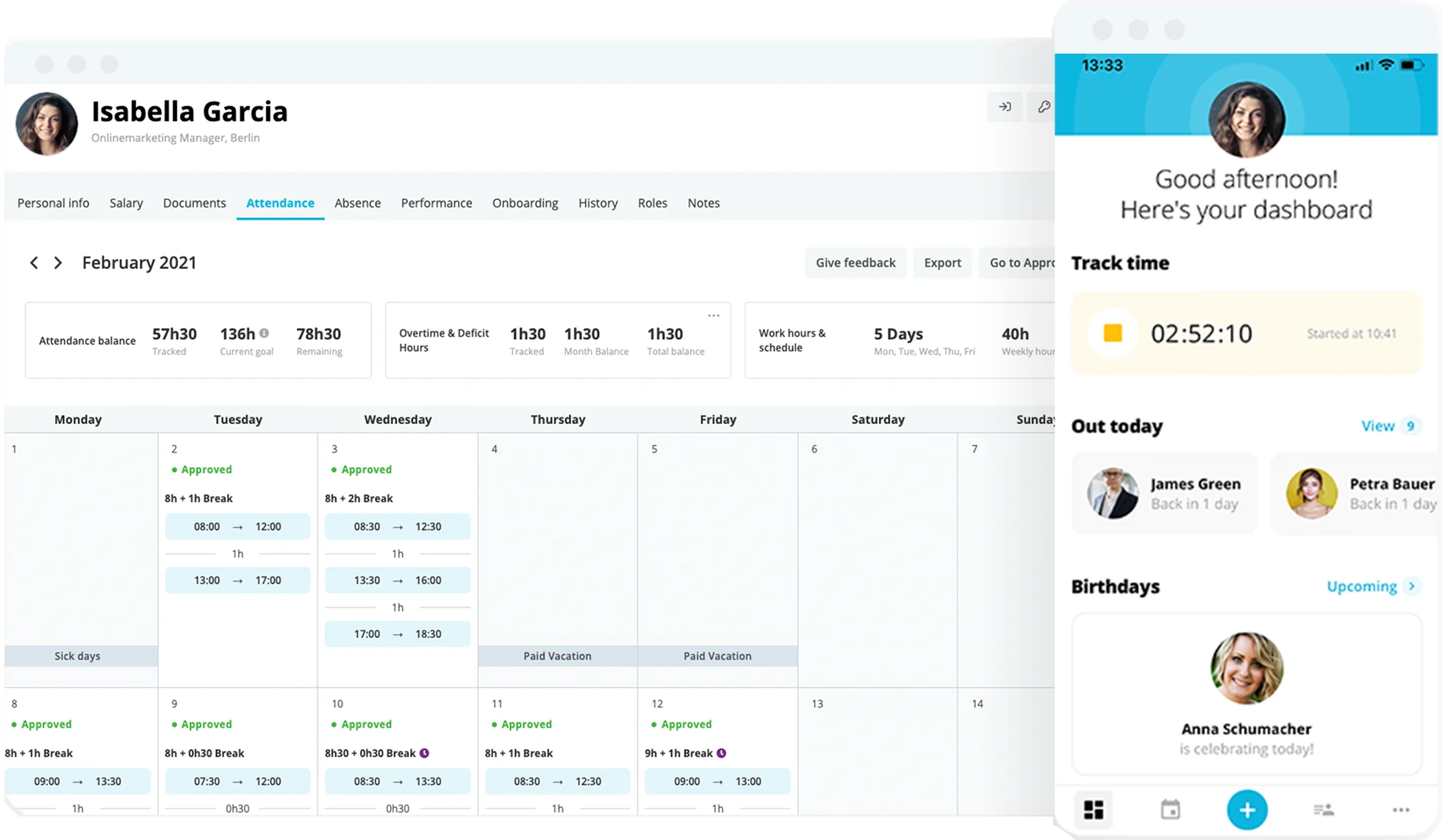
Discover Personio
An easy-to-use HR management system for your teams.
Latest blog posts, hr strategy defined: how to build & execute one (+ examples).

An HR strategy doesn't just serve HR. When developed and implemented correctly, it can help HR teams, executives and employees alike. In fact, an HR strategy can have a profound effect on an entire organisation.
So, why is having a strategy so important? What are the key steps involved? How do you get buy-in from the highest levels of your organisation? In this article, we offer a plan (and some helpful examples) to get your strategy off the ground.
- 1 What is an HR strategy?
- 2 How to develop an HR strategy in 5 simple steps
- 3 10 examples of great HR strategies
- 4 How do you determine the success of an HR strategy?
- 5 Execute your HR strategy today with Personio
What is an HR strategy?
An HR strategy is a plan or roadmap for solving an organisation's top challenges through their people. It lays out initiatives to leverage human capital to assist in efforts surrounding recruitment, onboarding, performance, corporate culture and other goals.
What is the purpose of an HR strategy?
The purpose of a strategic HR strategy is to align the skills and goals of your people with the goals and objectives of your business. The idea is to plan out a concrete set of measures, programmes and KPIs to reach those objectives.
There is also an incredibly important grounding element to an HR strategy. For many businesses, it sets into motion the importance of people and has a trickle-down effect on programmes like candidate experience , onboarding , performance reviews and more.
Is an HR strategy the same as a people strategy?
Yes and no. A people strategy is more of a "prioritised people plan" that sets out how your organisation seeks to develop employees in line with your goals. Your HR strategy is going to take a more holistic view and reflect business outcomes.
As an HR professional, you are going to want to have both an HR strategy and a people strategy in that order. The former will help prioritise what your team needs to accomplish, and the latter will unlock the power of your people to get there.
Why you need a human resource strategy
Successful teams require an HR strategy to help align their own goals with the goals of the business. This is important for two reasons:
It helps HR teams establish a seat at the table of executive discussions.
It showcases that HR, as a function, is designed to serve the overall business.
A human resource strategy is important because it showcases the true role of an HR or people function: to help the business through human capital. Leveraging the skills of your workforce by creating a better working environment for everyone.
Start building your own people strategy with our guide
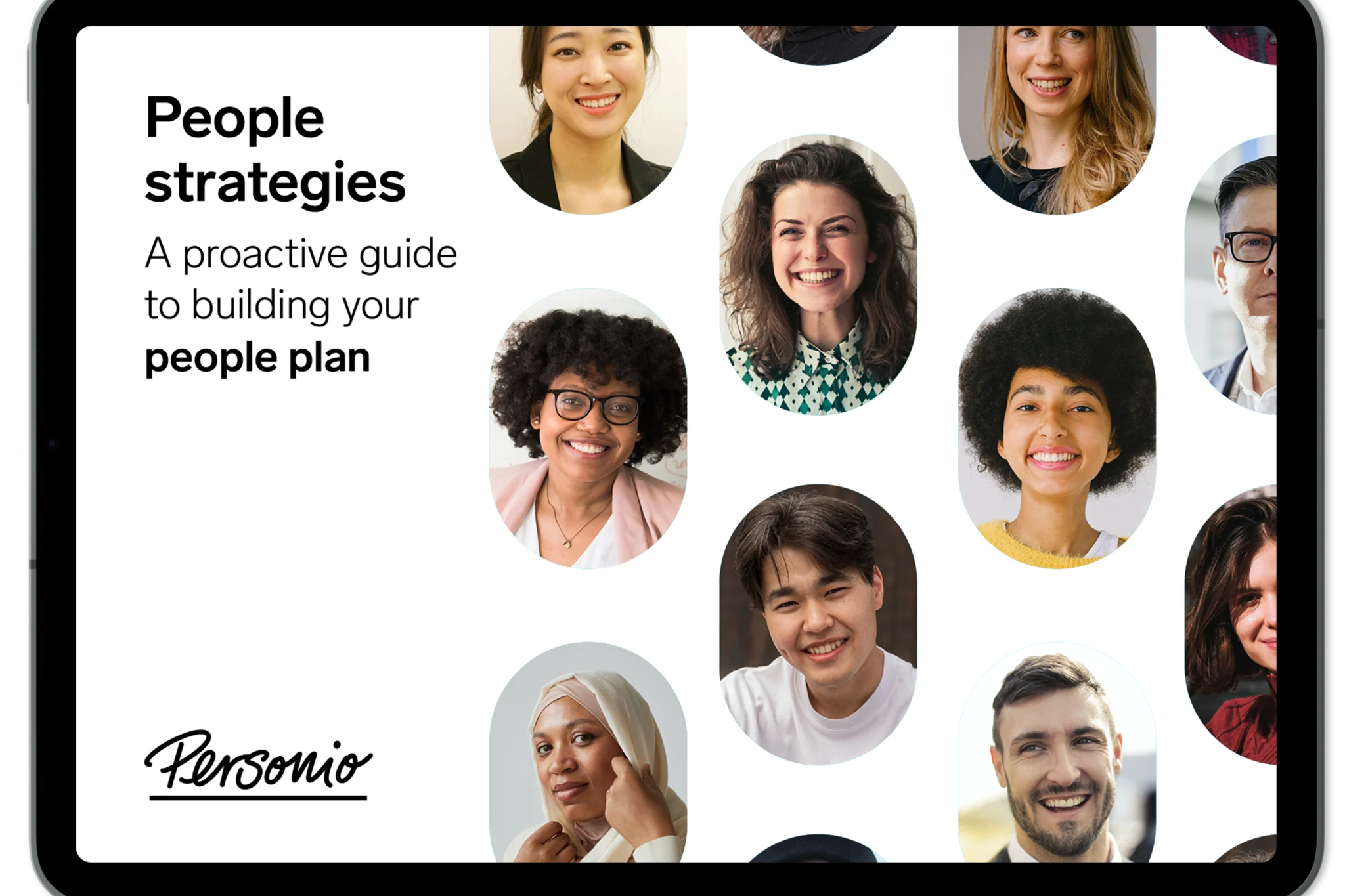
Through the lens of Personio's own Chief People Officer, we built a helpful guide to developing your own people strategy. Grab a copy for yourself right now.
How to develop an HR strategy in 5 simple steps
We put together this five-point plan to show you how you can start building an HR strategy in just a few steps. Here's how we'd recommend approaching things...
Step One: Define Success
For example, if your organisation aims to expand globally, HR can focus on talent acquisition strategies that cater specifically to international markets. This could then be tied to headcount goals in certain parts of the world.
Step Two: Adapt Goals
For instance, if your organisation is putting emphasis on innovation, consider revising your HR strategies to attract and retain innovative talent. Maybe you need to roll out an innovation or accelerator hub or host a company-wide hackathon.
Step Three: Define Measures
As an example, if your goal is to enhance employee engagement, you can start by building programmess such as mentorship initiatives or employee recognition programs. Try to focus on those concrete measures that feel the most tangible.
Step Four: Gain Buy-In
You could create workshops to educate managers about the benefits of new performance appraisal methods, gaining their support in the process. Make sure to focus on new initiatives being beneficial and how they help your target persona.
Step Five: Measure Success
To measure success, you could track turnover rates and employee satisfaction scores to measure the impact of retention-focused programs. Establish a floor, a best-case scenario and a baseline, and plot your organisation there to showcase progress.
10 examples of great HR strategies
Need a little bit of inspiration to bring your next great HR strategy to life? Based on the five-point plan above, we've got ten examples of programmes your HR team can implement to reach your goals (no matter what they are).
1. Talent acquisition: Targeted recruitment

To solve for the company goal of hiring more talented people, your HR team launches a targeted recruiting campaign to attract top talent from top schools.
They attend campus job fairs, partner with educational institutions and use social media advertising to attract high-quality candidates.
The goal : Reduce time-to-hire and improve the quality of incoming talent.
2. Diversity and inclusion: Affinity groups
A company-wide goal is to leverage the positive benefits of diversity and inclusion on employee engagement, satisfaction and performance.
To do this, HR forms "affinity groups" to meet regularly and provide input directly to HR and management on how the company can do better on DEIB.
The goal: Improve workplace culture and foster a more diverse workforce.
3. Employee engagement: Quarterly pulse surveys
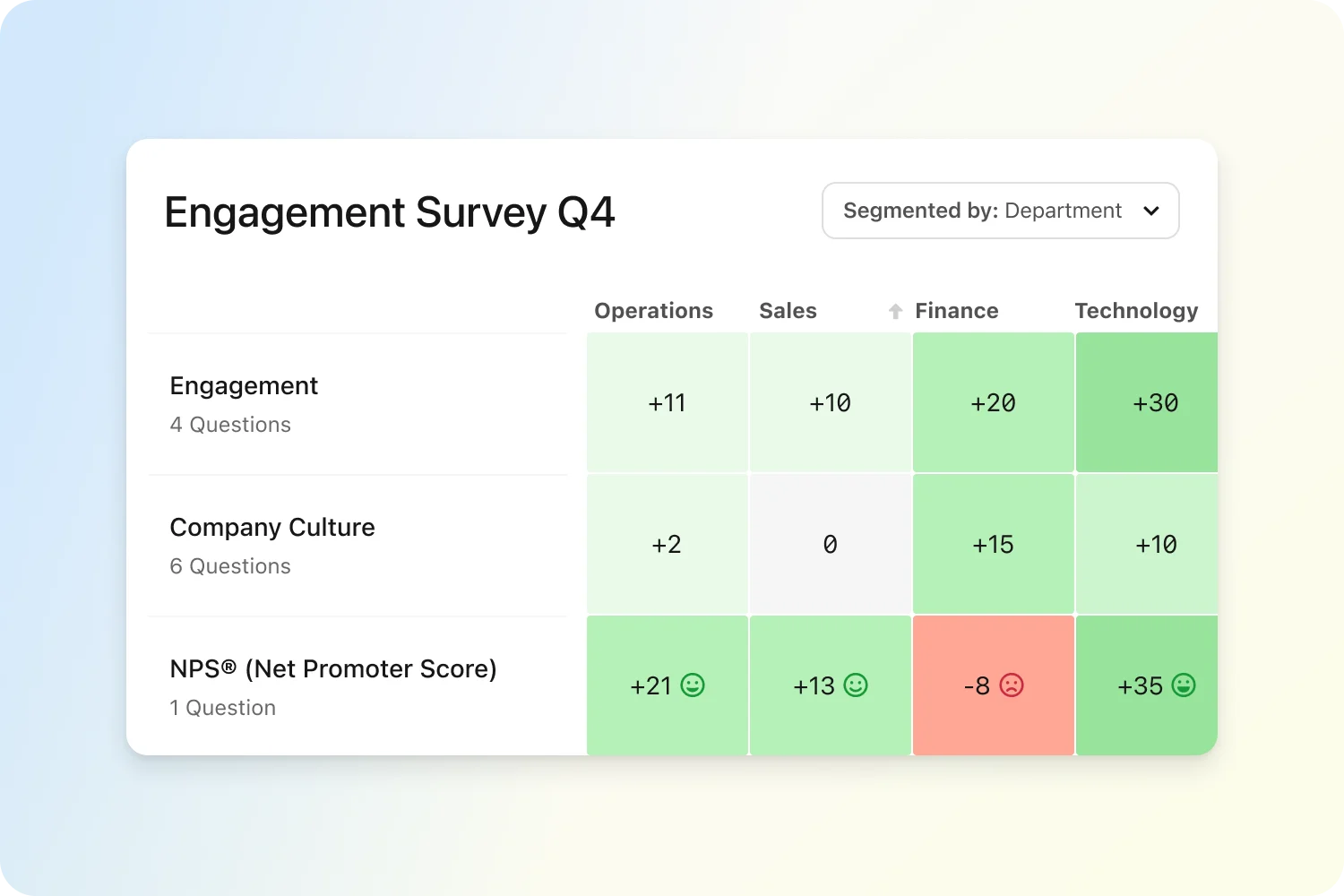
To maintain high levels of satisfaction and retention, your HR team initiates a programme of quarterly pulse surveys .
Your team runs short, anonymous questionnaires that ask employees about their experiences and perceptions.
The goal: HR can use the feedback to identify areas for improvement and strategies to increase employee engagement.
4. Employee retention: Flexible work arrangements
Your business is struggling with retention. Employees no longer want to work in the office, and are demanding more flexibility (or they're leaving).
HR develops and runs a hybrid working programme which seeks to boost employee autonomy by giving them the option to occasionally work from home.
The goal: Boosting employee retention and reducing regretted attrition rates .
5. Learning and development: Upskilling programmes
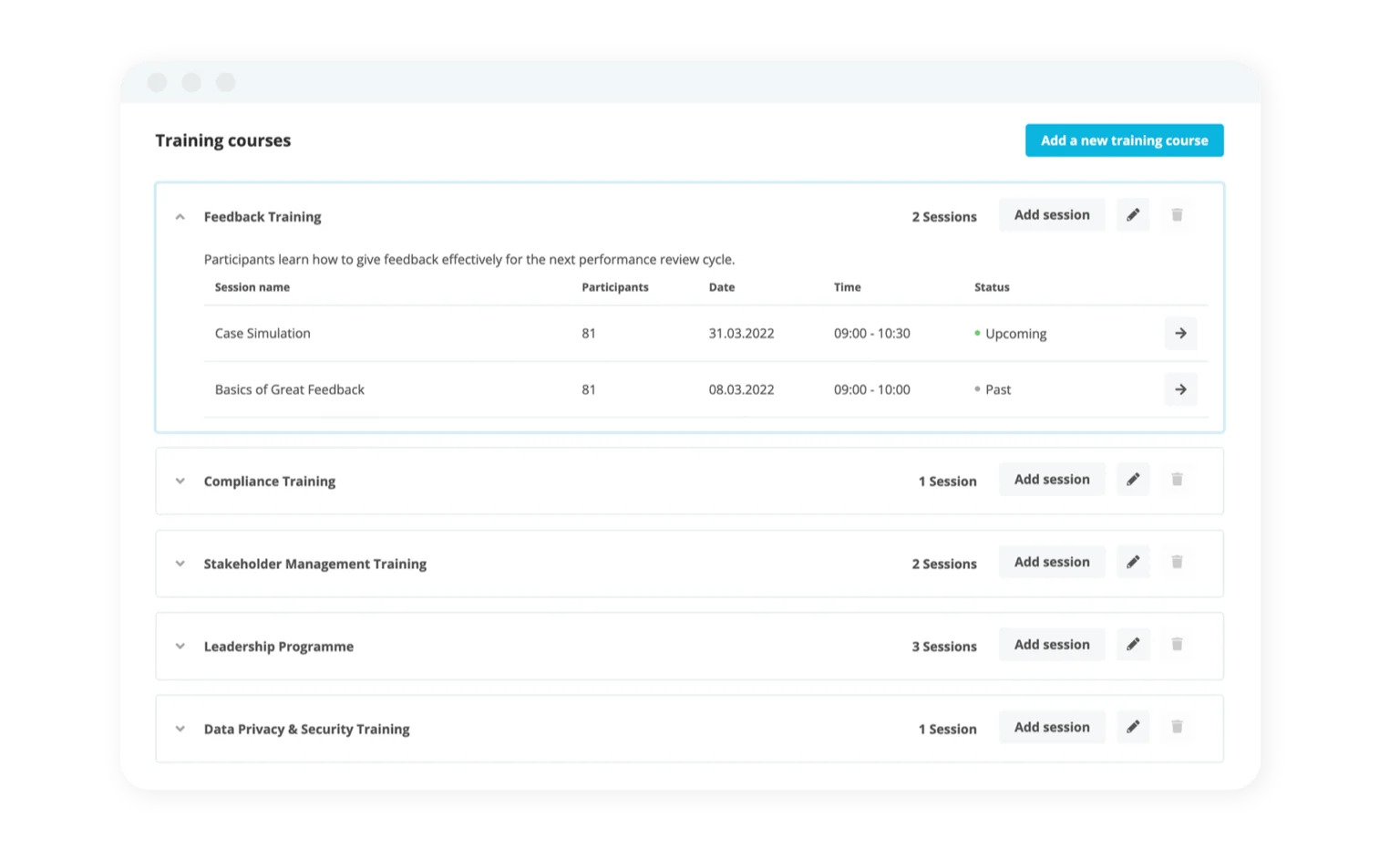
Your business identifies the lack of a key skill. Let's take project management as an example, which is impeding the ability to complete projects on time.
HR identifies this gap and runs upskilling training for all current employees to "raise the bar" of this skill without having to open the budget for more headcount.
The goal : Employee completion of training (as a percentage) followed by the knock-on positive effects on productivity and project completion.
6. Succession planning: Leadership development
A goal from the executives is to boost the strength of your leadership bench (without having to invest in massive hiring budgets to bring in new managers).
To do this, HR identifies high-potential employees and enrolls them in a leadership development programme. This includes mentorship, leadership training, and cross-departmental projects to prepare them for future leadership roles.
The goal: Have a talent pool of internal candidates ready for promotion, reducing the need for external hires for critical roles.
7. Compensation and benefits: Pay-for-performance model

Employee performance is becoming a massive issue for your leadership team. They want to give your workforce a shot in the arm to close out the quarter, half or year.
Knowing this, HR introduces a pay-for-performance model, where a portion of employees' compensation is tied to specific performance metrics. This strategy is communicated clearly to all employees and is designed to motivate high performance.
The goal : Boost performance and hit revenue targets.
8. Employee wellbeing: Health and fitness incentives
Employee satisfaction is plummeting and your executive team is beginning to notice. Your team knows it's due to employee wellbeing trending downward.
To combat this trend, your HR team launches a wellness programme that includes discounted gym memberships, weekly yoga sessions and free healthy snacks in the office.
The goal: Track participation rates and conduct surveys to measure its impact on employee wellbeing and productivity.
9. Employee relations: Open door policy
Communication is faltering. Your executive notices this, and wants to make effective communication a tentpole strategy for your entire organisation.
As a way to help with this, HR implements an "Open Door Policy," encouraging employees to directly speak with managers or HR about any concerns, feedback or suggestions. They also set up a whistleblowing channel for more sensitive issues.
The goal: Fostering a culture of openness and trust, and preemptively addressing issues before they escalate.
10. Onboarding: 90-day integration plan
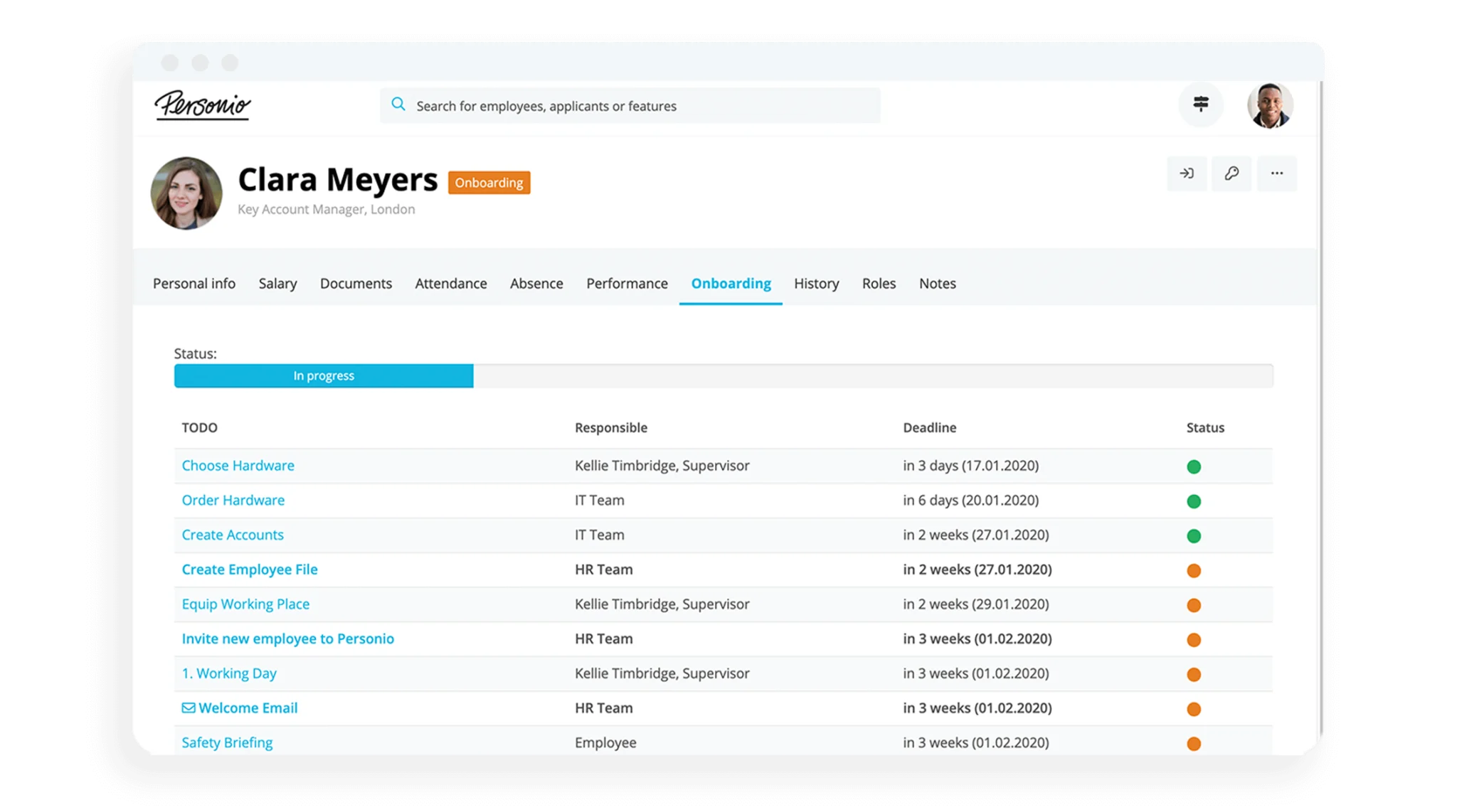
Your executive team is wondering why new employees struggle to learn your ways of working and perform in their first three months.
In order to solve that, HR develops a comprehensive 90-day onboarding programme for new hires. The program includes orientation sessions, training modules and regular check-ins with both peers and managers.
The goal: Accelerate the integration of new employees into the company culture and operational processes, thereby improving time-to-productivity.
Onboarding programmes? We can help with that

Personio can help your HR team build a comprehensive and automated onboarding programme that sets employees off to a flying start. Let us show you how it works and how our all-in-one HR software can benefit your entire HR strategy.
How do you determine the success of an HR strategy?
HR needs to proactively reach out to top-level management and figure out how to define success. Take the initiative and ask your management team some of the following:
What success factors and metrics drive company performance?
How can HR help achieve those things?
Are there other ways HR can support the management team?
Based on these answers, you should be able to derive some concrete goals. Some examples might include:
Increase overall employee productivity
Reduce or optimise hiring costs and ROI
Promote sustainability or DEIB across the organisation
Take those successes and drill them down further. Determine some key performance indicators (KPIs) which you can use to interface with management. Being truly data-driven here is going to benefit your team a bunch.
How do you measure the success of an HR strategy?
Even the best measures are of little use if you can't derive any insights from them. If you also want to convince management that HR is contributing to company goals, data is your friend and partner.
Did you know that only around 25% of HR professionals use data when it comes to evaluating the success of their HR work?
To do this, work with correlations (if in one department employees are very satisfied and turnover and absences are low, and in another, they are just the opposite, then you can make a connection) and draw comparisons. Finally, create a measure for each of your measures and compare results after specific intervals of time.
Execute your HR strategy today with Personio
The best HR strategies are only possible with HR software . That's because an HR software takes care of all the tasks that allow your team to make room for strategy.
Think about it like this, if your team is expected and wants to focus on the large-scale programmes that drive business success, who is going to focus on:
Employee data
Running programmes
Managing and assigning tasks
Reminding people to complete tasks
Beyond that, an HR software like Personio's can help introduce an evolving level of automation for things like onboarding, performance reviews and plenty of other processes that feed into your HR strategy.
Our advice? Speak with an HR expert today to share your top challenges and strategic objectives. We can show you how Personio has helped companies just like yours .
Bring your HR strategy to life
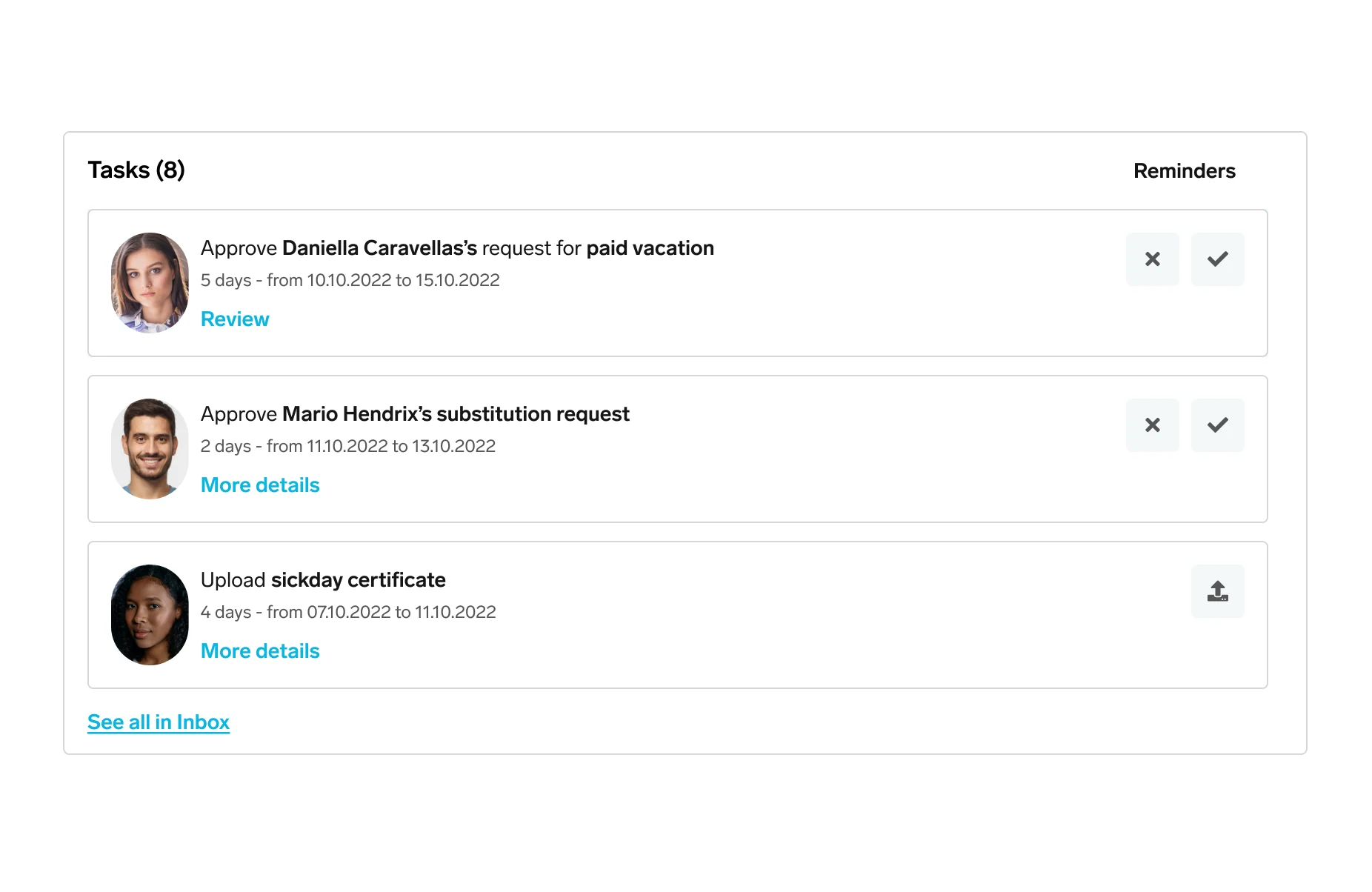
What's the Best Way to Present HR Analytics? 15+ Expert Tips

As an HR professional, you have access to people data that can be used to transform culture and kickstart engagement. Through HR analytics and reporting, you can unite departments and empower people to do their best work. Sounds pretty great, right?
But if all that HR data lives in siloes, change will be slow and decisions will be made without all the facts.
That’s where HR analytics presentations come in. With an effective HR presentation, you can package all that good HR analysis into a powerful story that persuades company leaders and positively influences decision-making..
Read on to discover pro tips on building presentations with your HR analytics, including advice from experienced HR pros and tips from BambooHR's in-house team of expert graphic designers. Through data, reporting , and effective HR presentations, you’ll be able to secure your seat at the table when it comes to strategic decision-making.
4 Fundamentals of HR Analytics Presentations
Align the presentation with company goals.
Simply put, your leadership team needs to know that the HR data you’re presenting on will impact the company’s goals and overall mission. Try to connect each data point to a key objective. For example, if one of your company’s initiatives is to improve employee retention , you can speak to employee satisfaction and how it directly affects that initiative.
Include The Financial Impact of HR
Money talks. When possible, include dollars and cents as they relate to overall financial goals. What’s the cost of labor for each employee? How much could the company save on office space if more employees went fully remote?
Build The Presentation Around The Key Takeaway
HR manager Jenny Wells expressed the importance of defining key takeaways. She says, “I try to structure HR presentations by always starting with what I want the audience to take away from it.” At the end of her talk, she makes a point to circle back.
Tailor The Presentation To Your Audience
The HR analysis should be relevant to the audience you’re presenting to. Put yourself in the shoes of your audience and ask yourself these questions: Why do I care? What can I do about it? For example, your finance team may find more value in compensation trends, where your managers might want to dive deeper into performance metrics.
Powerful data insights are only a click away.
With BambooHR, you can manage and report on your sensitive people data with an organized, secure database—no technical experience required.
Best Practices for Using Visuals in HR Analytics Presentations
A picture is worth a thousand words—and that's especially true when it comes to HR presentations.
Any HR analysis is likely chock-full of people data, and people data means numbers. You’ll not only better tell the story of the HR impact by using visual strategies in your presentation, but you’ll tell it in a way that your audience can understand.
To make sure your message hits home, consider incorporating the following best practices into your HR analytics slides:
- Keep it simple. If your audience is trying to read a block of text on your slides, they’re likely not listening to the verbal part of your presentation. Keep the amount of words to a minimum, and prioritize key takeaways on your slides.
- Add visual interest. Illustrate your main points through data visualizations such as pie charts, graphs, flows charts, images, and videos. These will help engage your audience and make your HR data more digestible.
- Use visual hierarchy. The gist of visual hierarchy: Make the most important information bigger, bolder, and in contrast to less important information. You can accomplish this by using fonts, colors, shapes, and more. Read up on the fundamentals of visual hierarchy here .
- Weave in some humor . HR data may fire you up, but the standard HR analysis might not be quite as exciting to others in your organization. Adding a dose of humor can really help bring the message home. Perhaps you can kick it off by providing a funny video, image, meme, or quote that pertains to your topic. (Just be sure it’s office-appropriate.)
- Provide short snippets . Avoid providing too much information, and use bullet points and numbered lists to make your HR presentation short and sweet. You may know ten reasons why an organization should make the switch to e-signatures , but you’ll want to limit your points to four or five. When in doubt, include hyperlinks to additional information for the people who may want or need more context.
Free Download: Make Your Data Shine.
Linking people data to business outcomes is a critical measure of how your business is performing and a way for HR to show up as strategic players.
5 Methods for Engaging Employees in Your HR Analysis
It’s not always easy to get a roomful of employees involved and engaged. Try using these tips to increase audience participation and attention so your people can absorb the information they need.
Arrange Discussion Groups
“Pairing people for discussions and forming small groups really helps all people participate,” says Stan Kimer, an HR consultant with more than 30 years in the field.
Small groups allow your audience to dive deep into the HR data you’re presenting, and a discussion format encourages deeper critical thinking. Consider giving each small group discussion questions to kickstart the conversation.
Reward Participation
HR consultant Joshua Evans recommends not only facilitating participation, but rewarding it: “Work to involve the audience by asking non-rhetorical questions, playing games, or even offering prizes for participation.”
Vary Your Presentation Style
You probably don’t love the idea of staring at a screen for an hour, right? Neither does your audience. Alternate between slides, discussion, activities, and hands-on education to keep your audience engaged.
Develop Interactive Materials and Handouts
To hold the attention of your audience, consider adding a handout to your presentation where they can take notes and write down any questions. You could also incorporate some fun, short quizzes or surveys to which your audience can respond online using virtual tools such as Poll Everywhere .
Bonus Tip: Handouts double as tangible resources for attendees to look back on at their convenience.
Work The Room
One thing our experts all agreed on: stepping away from the whiteboard to engage with the audience. Moving around the room is a great way to capture attention and is much more effective than staying in one location and lecturing from a single spot.
For virtual audiences, online whiteboards like Miro, Mural, and Stormboard are engaging and Zoom-friendly.
How to Measure the Success of an HR Analytics Presentation
As with anything in work and life, understanding the success of your HR presentation will help you improve future HR reporting and pinpoint any action items that came from the presentation. Here are some strategies to measure the success of an HR presentation:
Use Surveys & Evaluations
Several experts suggest ending your presentation with a short questionnaire or evaluation. Here are some sample questions to include in your survey:
- Did you learn something new from this presentation?
- Do you have any follow-up action items after attending this presentation?
- What are your key takeaways from this presentation?
For full participation, make your surveys quick and easy. You could even conduct a brief evaluation using a mobile survey app , so everyone can use their smartphones to provide feedback on the spot.
Schedule time to speak with your attendees afterward to get a feel for how well they absorbed the information.
You can frame this in terms of interaction in order to give you an in to follow up: “I wanted to follow up on your question about ____ in the HR presentation. Do you have any additional questions?” or “I noticed you didn’t get a chance to ask your questions during the HR presentation. Is there anything I can dive deeper into for you?”
Seek Hard Metrics
You can also try to measure the success of your HR presentation using hard metrics. For example, if your presentation was about career development opportunities, you could measure how many employees participated in development initiatives like leadership training or tuition reimbursement.
Manage employee data the easy way.
Say goodbye to outdated spreadsheets and hello to centralized employee records! From electronic signatures to tax documents, BambooHR keeps employee data organized and secure.
- Help Center
- Small Business
- Staffing Agencies
- Search Types
- Service Model
- Employment Credit
- Criminal Searches
- Drug Testing
- Occupational Health Services
- Social Media
- Education Verification
- Employment Verification
- Civil Records
- Driving Records
- DOT Solutions
- Diversity & Inclusion
- Why ScoutLogic ?
- Background Check 101
- Recruitment
- Human Resources
- Why ScoutLogic?
- Background Check Compliance
- Background Check Search Types
- Credit Background Checks
- Employment Drug Testing & Screening Service
- Occupational Health Screening Services
- Education Verification Background Checks
- Employment Verification Service
- Civil Background Checks and Court Records
- Driving Records Search Types
- DOT Background Check Compliance Service
- I-9 & E-Verify Background Check Service
- Meet Our Team
- Diversity & Inclusion
- Compliance Blogs
- Recruitment Blogs
- News & PR Blogs
- Human Resources Blogs
7 Examples of a Good HR Strategy
HR management is the glue that holds the company together. Its organizational role has become more vital in the last few years as worker demands have changed and labor shortages have made scouting top talent much more competitive.
An organization that wants to be the place where employees want to work needs to keep up with these changes and rethink its HR strategy. A good HR strategy can mean the difference between high retention rates and high turnover.
Below, we share the top HR strategies to implement to keep your organization at the lead. Use these methods to equip your HR department so that they can rise to the challenge of creating and maintaining a vibrant and effective workforce.
What Is an HR Strategy?
An HR strategy is a systematic approach that optimizes the work of human resource management. Since HR activities may vary from pre-employment screening and onboarding to employee benefits and disputes, developing a sound strategy will require looking at the HR management in its entirety. The preliminary assessment should consider a company’s goals, values, and vision and build a path forward to incorporate them.
The best strategies are innovative beginnings. They may require some tweaking, but with care and consideration, they should put you on a path towards an efficient, sustainable workplace.
Why Is HR Strategy Important?
HR strategy is more critical than ever. Employees everywhere are renegotiating and changing the standard of what they expect from a company, and organizations need to respond to keep up with today’s workforce. At the end of the day, people are the lifeblood of any business.
The cost of turnover because of poor hiring practices and a lack of in-company support can be astronomical. Consider a recent study that found the average cost of a bad hiring choice is at least 30% of that employee’s first-year earnings.
Finding and attracting the right person to meet your company’s specific needs is essential if you want to invest your earnings into your business’ growth. And all of that starts with your HR strategy.
7 Best HR Strategies
1. efficient hiring practices.
If your company is missing an essential piece of the puzzle, it’s your job to figure out how to fill that gap. Creating a hiring profile is vital for getting the right resume on your desk.
Businesses don’t have the luxury of approaching hiring from an “I’ll know it when I see it” standpoint. Creating a specific, thoughtful hiring profile will help applicants put their best (and most relevant) foot forward. It can also save you a lot of groundwork digging through a pile of non-qualified resumes.
It’s important not to keep promising applicants waiting because of a slow background check. In today’s competitive job market , while you’re waiting for the results to come through, your frontrunner might be scooped up by another company. For an efficient hiring practice, you have to consider every aspect, from the job post to the screening.
2. Real-Time Communication for Feedback and Appreciation
The corporate mentality has left a lot of employees feeling disenfranchised by their work. Many employees say they’d prefer to forgo performance reviews for real-time evaluation. This mindset represents a cultural shift from accountability to learning .
Admittedly, hands-on, real-time feedback creates more work up-front. However, in the long run, staying connected with your workforce through regular communication, feedback, and appreciation is vital to its sustainability. A company with a high turnover rate spends too much of its valuable energy and resources recruiting instead of focusing on the team building required to meet its yearly goals.
As new hires get oriented to your company, check in with them weekly to see how their new position is going. Attentiveness can make all the difference in retention and provide clarity between job expectations and realities.
It’s important to remember that almost all employees want to excel at their jobs. Regular feedback will make your employees feel seen and appreciated while giving them the tools they need to initiate their growth.
3. Growth Opportunities
This constant communication should create a sense of progress and opportunity for the employees seeking it. A stagnant worker is an unhappy worker. Creating opportunities for training, mentorship, and team building keeps your workforce engaged with a healthy sense of challenge and connectivity.
Workplace events can help build a sense of camaraderie, as well as foster connections between departments that generally might not cross paths. So many great ideas fall through the cracks because there is no space to share and compare notes and experiences. Workplace events can help to replace a sense of cutthroat competition within your company and replace it with cooperation and collaborative creativity.
Mentorships are crucial to providing your employees with a sense of growth and satisfaction. People of Color and women have said that formal mentorship has been an enormous benefit to their careers. Mentorship can also aid in employee retention by fostering intra-personal connections.
When it comes down to it, personal growth will correlate with company growth. If your company is stagnant, your employees have likely felt that stagnation for quite some time.
4. Competitive Salary and Benefits Flexibility
Staying up to date on the going-rate salary for each job description and keeping tabs on the duties and expectations across companies is a must. While each HR team will be working with different budgets, knowing what’s out there is essential. Your workforce will know this, especially if you ignore our third strategy.
While you can’t always compete with every company’s budget, what you can do is know the job duties that are required and their corresponding salaries. Compare and contrast this with other companies and find what makes your organization’s offerings unique.
Benefits are another way of encouraging company loyalty. There are some things money can’t fix, such as the difficulty of dealing with a bad insurance company. Offer your employees tiers of insurance with the flexibility to meet their (and their family’s needs). It is just one way of making your workforce feel supported and cared for on a person-to-person level.
5. Equity, Diversity, and Inclusion (EDI)
Diversity is the future. It’s how we incorporate new ideas and strategies into our lifeblood. It fosters innovation and resilience and aims to make every person in your team feel seen and heard, regardless of race, gender, sexuality, or different abilities.
Equity, Diversity, and Inclusion are non-negotiable for modern-day companies. EDI work begins with your hiring practices but continues into your everyday work environment.
Your company must do more than just the yearly unconscious bias training in today’s world. Your organization should be building and analyzing EDI data regarding recruitment, progression, access to growth opportunities and development, and attrition.
Maintaining comprehensive data will help to foster a commitment to EDI that goes beyond box-checking and is an overarching perspective for your company. This data can illuminate the bigger picture and help you see beyond your institution’s best intentions to recognize the patterns beneath the words, good or bad.
6. Corporate Social Responsibility
As the millennial generation takes center stage in our workforce, the expectation that companies take social responsibility is higher than ever. It’s safe to say that trend will continue with Gen-Zs and well after.
Corporate Social Responsibility (CSR) is the philosophy that businesses are responsible to the communities around them. There are three prevalent social responsibilities that are at the forefront of concern: Environmental, Ethical, and Philanthropic.
With cities worldwide reaching record temperature highs , employees are asking more than just their governments to act on global warming. Employees expect commitments like reducing pollution, increasing reliance on sustainable energy, and offsetting the negative impacts of your company’s contributions to climate change.
Ethical responsibility speaks to fair treatment of all company stakeholders, from leadership and investors to employees, suppliers, and customers. Sourcing products and components according to Fair Trade standards is an excellent example of a company’s commitment to ethical responsibility.
With the prospect of committing almost a third of their lives to work, it’s no surprise that employees want their companies to give back. Philanthropic responsibility is a commitment to investing and bettering the communities around them. It acknowledges that a company has a duty to make the world a better place through economic and cultural means.
7. Employee Wellbeing
The United States just initiated its first nationwide mental health hotline. Now more than ever, both sides of the American aisle seem to agree that mental health is just as important as physical health. But the well-being of your employees is hard to track.
This point returns us to our second strategy. Communication and appreciation open the doorway to more profound consideration. It’s impossible to gauge the well-being of your employees if you do not regularly check in with them.
As the workplace is more remote than ever, it’s crucial to incorporate the lessons we’ve learned about burnout and sustainable work practices to promote mental health.
Incorporate check-ins during small meetings, and foster a company culture of care. It might initially feel like you’re wasting valuable company time. However, studies show that even five minutes per day checking in can be enough to keep your workforce in a mindset of self (and community) care.
What Makes a Great HR Strategy?
Creating a great HR strategy takes a commitment to understanding your company, its values, both, and its aims for the future. It involves talking to your workforce and recognizing the gaps between those aims and the resources your team has to achieve them.
Any successful HR strategy seeks limited turnover while also planning for succession within the company. It encourages and incentivizes its employees with regular audits of their compensation, benefits packages, and work environments.
More than anything, an HR strategy is made great by the people who implement it. Real-time follow-through, adjustment, and consideration of feedback create strategies that are as fluid and changing as the people that enact them.
With these seven strategies as guideposts, you can reconsider and shape your company’s needs and lead it further down a path of positive, sustainable growth.
Ready to implement the first strategy and make your hiring practices more efficient? ScoutLogic makes screening hassle-free, with a dedicated “Scout’ who works directly with your company. Our pro-active services give you more time to interview your perfect candidates.
Contact ScoutLogic and save your HR team valuable time and resources.

Download this free guide to go into the searching process prepared. This guide includes actionable steps to:
- Gather your requirements
- Determine vendors
- Check references
- Determine success metrics
Get a free e-book
- Book a Speaker
Presentations

Utilizing Independent Contractors and Other Gig Workers Training
This sample presentation is intended for delivery to individuals who hire and manage workers. It is designed to be presented by an individual who has knowledge of the law and best practices regarding independent contractor/gig worker classification.

Recognizing Hidden Bias
This sample presentation is intended for delivery to supervisors and other individuals who manage employees. It is designed to be presented by an individual who has knowledge of the concepts and best practices regarding unconscious bias in the workplace.

Documenting Employment Actions
This sample presentation is intended for presentation to supervisors and other individuals who manage employees. It is designed to be presented by an individual who is knowledgeable in both proper documentation and the employer's policy and practices.

Conducting Performance Appraisals Training
This sample presentation is designed to be presented by an individual who has knowledge of the employer's performance management and appraisal programs.

Confronting Workplace Bullying
This sample presentation provides training on what workplace bullying is and how to prevent it.
Recommended by SHRM
HR Daily Newsletter
New, trends and analysis, as well as breaking news alerts, to help HR professionals do their jobs better each business day.
Success title
Success caption
Newly Launched - World's Most Advanced AI Powered Platform to Generate Stunning Presentations that are Editable in PowerPoint

- Customer Favourites
Hr Strategy
Powerpoint Templates
Icon Bundle
Kpi Dashboard
Professional
Business Plans
Swot Analysis
Gantt Chart
Business Proposal
Marketing Plan
Project Management
Business Case
Business Model
Cyber Security
Business PPT
Digital Marketing
Digital Transformation
Human Resources
Product Management
Artificial Intelligence
Company Profile
Acknowledgement PPT
PPT Presentation
Reports Brochures
One Page Pitch
Interview PPT
All Categories

- You're currently reading page 1

Stages // require(['jquery'], function ($) { $(document).ready(function () { //removes paginator if items are less than selected items per page var paginator = $("#limiter :selected").text(); var itemsPerPage = parseInt(paginator); var itemsCount = $(".products.list.items.product-items.sli_container").children().length; if (itemsCount ? ’Stages’ here means the number of divisions or graphic elements in the slide. For example, if you want a 4 piece puzzle slide, you can search for the word ‘puzzles’ and then select 4 ‘Stages’ here. We have categorized all our content according to the number of ‘Stages’ to make it easier for you to refine the results.
Category // require(['jquery'], function ($) { $(document).ready(function () { //removes paginator if items are less than selected items per page var paginator = $("#limiter :selected").text(); var itemsperpage = parseint(paginator); var itemscount = $(".products.list.items.product-items.sli_container").children().length; if (itemscount.
- Business Plans (7)
- Business Slides (6478)
- Circular (327)
- Cluster (66)
- Complete Decks (598)
- Concepts 1 (160)
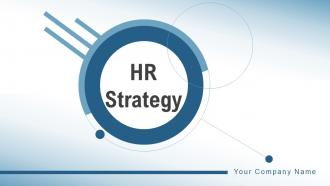
HR Management Slides
HR Management Slides and HR Management Tools
Brilliant HR Strategy Presentation
In this page, you can view all of 15 excellent powerpoint slides on HR Management. All slides are designed in powerpoint files (ppt) so that you can modify and immediately use for your own learning process.
There are 15 excellent HR presentation topics :
1. Competency-based HR Management 2. HR Scorecard 3. Principles of HR Management 4. Measuring ROI of Training 5. Change Management 6. Diagnosing Organizational Effectiveness 7. Good to Great 8. Coaching for Optimal Performance 9. Balanced Scorecard 10. Career Management 11. Communication Skills 12. Emotional Intelligence 13. Developing Leadership Skills 14. Presentation Skills for HR Managers 15. Creative Thinking Skills for HR Managers
You can download all of these amazing slides HERE
Related posts:.


COMMENTS
11 Successful HR strategy examples. 1. Google. Google's emphasis on data and metrics in people management sets it apart. The company revamped its HR policies for a more efficient and effective workforce, adopting a data-driven approach with people analytics to address organizational challenges.
Download a 186-page HR strategy template with professionally designed and easy-to-edit slides for hr & org strategy storylines, plans, frameworks, org charts, analysis, icons, examples, templates, and more. Designed by human resource leaders and McKinsey consultants, the template covers HR strategy, org strategy, org design, strategic alignment, financials, the employee journey, culture, values, compensation design, and much more.
Creating a persuasive HR strategy presentation involves a structured approach. Here's a step-by-step guide to help you craft a compelling narrative: . 1. Understand your audience: Start by understanding your audience's preferences, needs, and pain points. Tailor your presentation to resonate with their interests. .
Template 8: Human Resources Planning Presentation . Introducing the human resources planning presentation. This template is designed to help you create a strategic HR plan, develop an HRM plan, and assess your current HR capacity. With this PowerPoint deck, you'll be able to forecast your requirements and evaluate recruitment strategies.
Learn how to develop your HR strategy by focusing on values, norms, environment, benefits, and metrics. Download a free 186-page PowerPoint presentation template with best practices, frameworks, and examples.
Here are a couple of examples of HR strategic plans presented using various models: 1. Enhancing Employee Engagement Infographic of the Cascade Strategy Planning Model. ... Using jargon during a presentation may sound smart but may lead to confusion and alienation. To effectively communicate your strategies, prioritize using simple, plain ...
Here are six steps to help you succeed at the human resource planning process. 1. Assess current employees' skill levels. The first step to creating a future-forward HR plan is to assess employees' current skill sets, and compare them to your operational needs moving forward.
Slide 1: This slide introduces HR Management Strategy.State Your Company name and begin. Slide 2: This slide depicts Agenda. Slide 3: This slide shows the Outline of the presentation. Slide 4: This slide shows Human Resource Key Roles & Responsibilities. Slide 5: This slide depicts Human Resource Key Roles and Responsibilities. Slide 6: This slide showcases Skills Needed For HRM.
Keep the presentation focused. Start with the obvious: setting a clear agenda before starting. Define your key points and cover them within the time available. Tip #1: Don't be tempted to go off tangents or spend too much time introducing yourself. Tip #2: Leaving a visible timer running as you go is also a good idea.
HR Presentation Slide Templates. Number of slides: 10. Signup Free to download. The Human Resources template enables your HR managers to outline the most important things regarding human resource processes and organization. The true potential of a business lies in its human resources which adds to the complexity of leading the company.
Template 1: Strategic Human Resource Planning Process PowerPoint Presentation Slides. This PPT template will help users understand essential ideas, including organizational development, purpose and vision, and workforce planning. It assists you in producing workforce management strategies, models, and strategic workforce planning presentations.
How can you create a more human workplace that fosters trust, collaboration, and well-being? In this blog post, you will find seven successful HR strategy examples that work in 2023 and beyond. Learn from the best practices of leading organizations and experts on how to implement effective people practices and drive business outcomes.
The Human Resource or HR strategy is an overall plan for hiring, training, performance appraisal, compensation, and other key areas aligned with the organization's objectives. The fully customizable HR Strategy PPT has been designed amazingly by our professional designers to discuss the various aspects of the topic and leave a lasting ...
Start building out programmes (scroll down for inspiration). Step four: Gain buy-in. Any HR programmes is going to require management and employee buy-in. Think about ways to socialise and advocate for your measures to reach your goals. Step five: Measure success. A great HR department is driven by data.
10 HR strategies. An HR department can implement its strategies in many ways, depending on the organisation's goals and resources. Here are ten HR strategy examples an HR professional might consider using: 1. Develop a brand around the business culture.
Illustrate your main points through data visualizations such as pie charts, graphs, flows charts, images, and videos. These will help engage your audience and make your HR data more digestible. Use visual hierarchy. The gist of visual hierarchy: Make the most important information bigger, bolder, and in contrast to less important information.
7 Examples of a Good HR Strategy. HR management is the glue that holds the company together. Its organizational role has become more vital in the last few years as worker demands have changed and labor shortages have made scouting top talent much more competitive. An organization that wants to be the place where employees want to work needs to ...
This sample presentation provides training on what workplace bullying is and how to prevent it. New, trends and analysis, as well as breaking news alerts, to help HR professionals do their jobs ...
Slide 1 of 11. HR Strategy Organization Product Human Resource Process Individua Business Goals. Slide 1 of 34. Implementing HR Strategy Employee Journey And Work Culture In Your Organization Complete Deck. Slide 1 of 46. Creating Hr Strategy For Your Organization Organizational Design Models And Types Complete Deck. Slide 1 of 68.
The goals and strategies identified in this report are a result of a collaborative effort by the Human Resources leadership team with feedback and input from the HR staff and the Executive Vice President's office. The projects associated with these goals and strategies will continually evolve in ways that best align our support of UNM's
Brilliant HR Strategy Presentation. In this page, you can view all of 15 excellent powerpoint slides on HR Management. All slides are designed in powerpoint files (ppt) so that you can modify and immediately use for your own learning process. There are 15 excellent HR presentation topics :